Sustainability Report 2023
CHOICE. INNOVATION. SUSTAINABILITY.










CHOICE. INNOVATION. SUSTAINABILITY.









This year, with the release of our sixth sustainability report, we are reminded of how far Novolex has come with an ambitious, yet unwavering, commitment to fulfill our sustainability vision.
At the center of this commitment is our Novolex family, which makes our business a success.
As always, we work closely with our customers to provide packaging solutions from across our portfolio of brands that will meet their sustainability goals. Solutions include products made with recycled and renewable content that can be recycled, composted or reused. At Novolex, innovation requires engaging with our customers to better understand their sustainability goals. We focus on empowering their decisions. We strive to help our customers use data and information about the impact of raw materials and product designs to optimize the full lifecycle performance of their products.
There isn’t a role at Novolex that doesn’t have a significant impact on what sustainability means for us. Maintaining safe workplaces, innovating new products, reducing energy use, supporting our communities and many more initiatives all reflect sustainability at Novolex.
“
In return, we strive to develop our colleagues for careers, promote from within and reward performance through such programs as the Novolex Broad-based Employee Award Plan (BEAP), which offers the potential for employees to share in the benefits of the long-term growth of the company.
Across our facilities, we continue to elevate our efforts to be a best-in-class company in sustainability. In 2023, we continued to implement steps that will enable us to reduce our greenhouse gas (GHG) emissions 30% by 2030, launching a program across our manufacturing facilities to reduce energy use. Our plants continued to expand their safety programs to reduce risk through new procedures and intensive training.
Last year we continued to see the introduction and adoption of legislation and regulations affecting packaging. I am incredibly proud of the role Novolex plays in policy discussions that can shape the future of our industry. As both a packaging producer and recycler, we know recycling works and we are committed to bring our expertise to the table. Our goal is to promote wellcrafted public policy related to Extended Producer Responsibility (EPR) and other proposals by informing discussions around circular systems that can support our customers and consumers, as well as fulfill society’s broader expectations for packaging.
In 2023, Novolex grew, evolved and delivered on our sustainability vision. But our work is never done. Our more than 10,000 Novolex family members give our vision real purpose. With their unwavering focus and commitment, I am confident we will continue to grow our business sustainably, leading the industry with innovative packaging solutions in the years ahead.
STAN BIKULEGE CHAIRMAN AND CEO
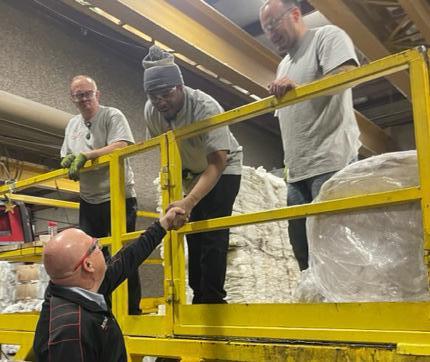




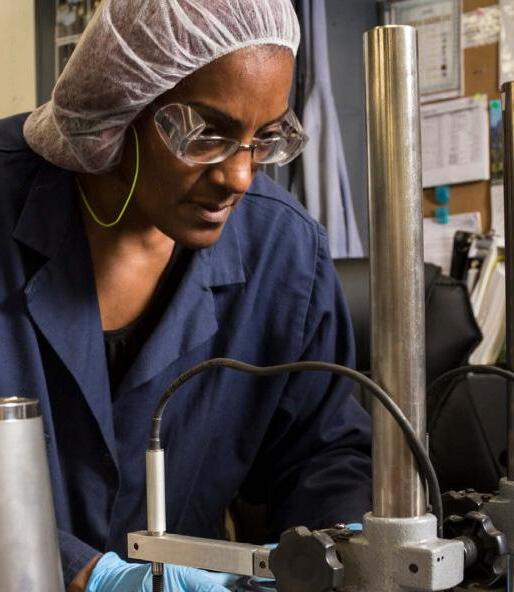


The Novolex family comprises more than 10,000 employees across 55 manufacturing facilities and administrative offices. We operate within North America and Europe to manufacture packaging and industrial products made from resin, fiber and multiple other bio-based and recycled materials. Our Food & Delivery and Performance Solutions business segments provide products that serve foodservice, delivery and carry-out, food processing and industrial markets. Novolex products offer superior performance, provide convenience, reduce waste and support food safety and hygiene for the benefit of millions of consumers who use our products every day. To learn more about Novolex and the products we make that provide packaging solutions for our customers and their consumers, visit us at Novolex.com .
As regulatory and voluntary sustainability frameworks and reporting requirements move toward greater alignment, our business and reporting aim to develop along with them.
We recognize that the language of sustainability continues to evolve. In this report we use the term sustainability to embrace a spectrum of initiatives—policies, programs, procedures, products and more—that align with environmental, social and governance (ESG) expectations. Novolex business strategy is influenced by all of these factors. We aim to be transparent in our sustainability programs and reporting as well through our communications with stakeholders who count on us to support their sustainability goals.


This report has been prepared in accordance with the Global Reporting Initiative (GRI) and supports the Sustainability Accounting Standards Board’s (SASB)
Containers & Packaging industry standard. In 2023, Novolex identified additional disclosure opportunities to further align with GRI. During this analysis, we also began our journey to align with the 2023 International Financial Reporting Standards (IFRS) for disclosures that are derived from the Task Force on Climate-Related Financial Reporting (TCFD) and SASB industry-based disclosure requirements. Our GRI Index is included in the Appendix.
Our report demonstrates our commitment to maturing our sustainability journey and reported metrics throughout the 2023 calendar year. The focus areas of the 2023 report are informed by the findings from our 2020 materiality assessment. Through daily conversations with multiple stakeholders Novolex is constantly identifying and analyzing emerging trends, issues and opportunities for additional disclosures and programs. Nonetheless, our priority material issues in 2023 remain unchanged from those we initially reported in 2020. For more information regarding our materiality assessment, see Appendix.
In 2023, two Novolex brands, Vegware™ and Eco-Products®, received B Corp certifications for their commitment to social and environmental programs and progress. B Corp certification recognizes organizations that are driven by a balance of mission and profit.
Also in 2023, we took initial steps toward completing a Climate Risk Assessment. The approach we are taking is consistent with TCFD principles. While our U.K. and E.U. operations currently do not fall in the scope of TCFD requirements, we are taking this step to ensure our efforts are in line with emerging global standards.

If you have any questions or comments about this report, please contact sustainability@Novolex.com.
Customers and other stakeholders increasingly use external rating platforms to asses corporate sustainability performance. In 2023, a core team at Novolex continued our focus on improving our EcoVadis responses and associated score. For our responses covering FY 2023, we received a Bronze Medal acknowledging Novolex standing among the top 35% of companies. An EcoVadis medal is an acknowledgment of achievement relative to other assessed companies across the EcoVadis database.
With an ongoing focus on operational efficiency and stakeholder engagement, Novolex has continued to pursue our sustainability vision to innovate more sustainable choices for our customers, operate responsibly and invest in our people and communities.
Through our communication with stakeholders such as customers, suppliers, communities and other industry partners, we work to identify additional metrics to measure our performance, strive to improve our data collection methods and, where appropriate, develop targets to focus initiatives across our business. Since the publication of our first sustainability report covering FY 2018, we have continued to adopt various key performance indicators (KPIs) to monitor our progress and drive alignment on the key actions that will contribute to a resilient, sustainable business model. All our reported metrics align with the sustainability pillars shown below.
Products: Take on a leadership role within the packaging industry by providing customers and their consumers with sustainable product solutions.
Percentage of raw materials from renewable, post-consumer recycled (PCR) or bio-based sources
Percentage of PCR in procured resin and fiber
Percentage of certified fiber
Percentage of revenue from products that are recyclable, compostable or reusable
Double PCR recycling in our North Vernon, Ind. recycling facility by the end of 2024

Operations: Strive for low-impact manufacturing and integration of sustainability into operations excellence.
People and Communities: Support our employees, their families and communities and the consumers who use our products.
Reduce GHG emissions from energy use in manufacturing by 30% per ton of production by 2030
Significant air emissions
Waste management and footprint
Safety: Total Recordable Incident Rate
Percentage of females and minorities in leadership positions
Employee demographics
Internal promotions
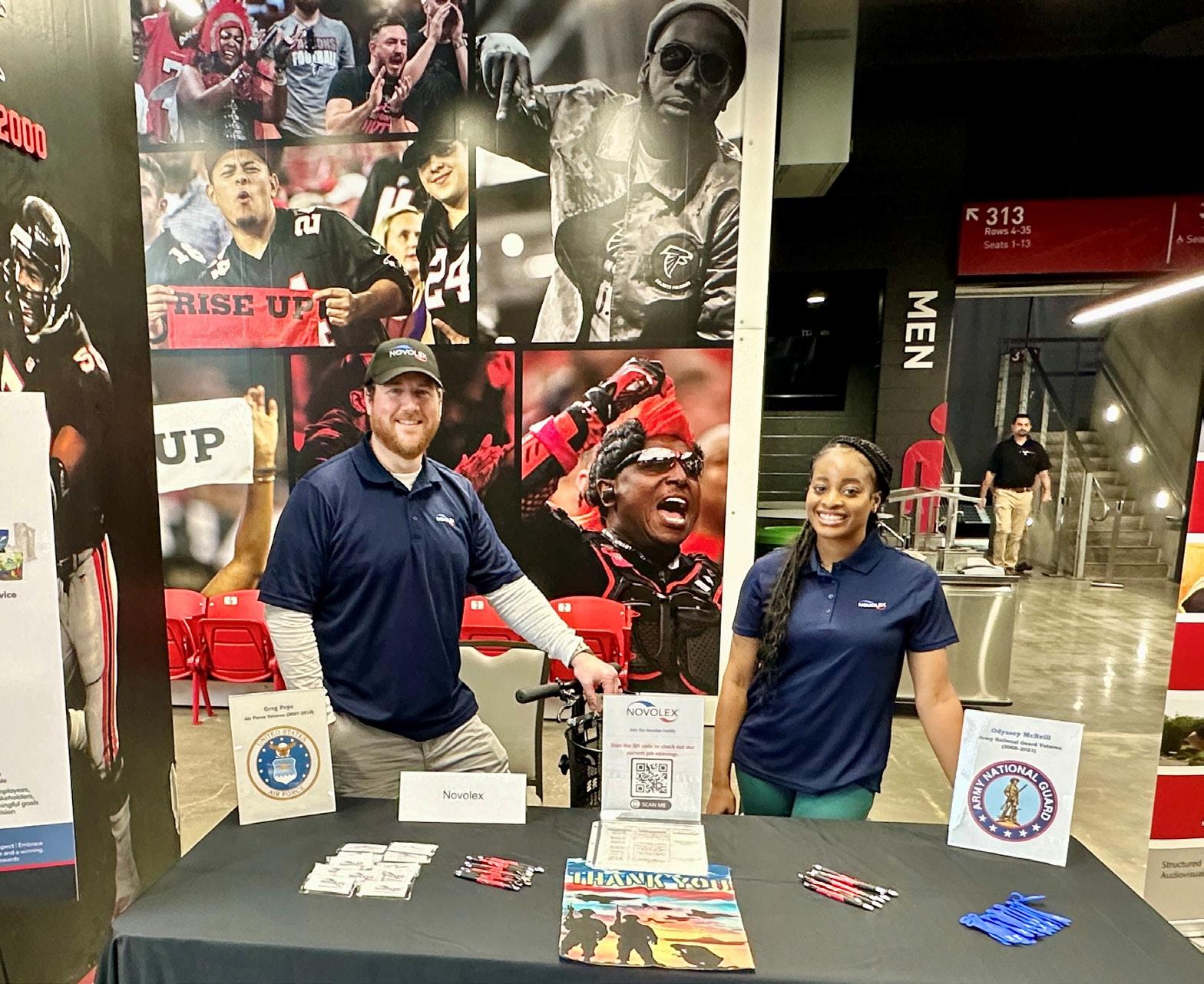
Multiple regulatory standards and voluntary reporting frameworks such as GRI, SASB, IFRS, TCFD, the World Business Council for Sustainable Development and the Global Sustainability Standards Board require the reporting of Scope 1 and 2 emissions but reporting Scope 3 emissions is optional. Novolex completed an initial Scope 1 and 2 GHG inventory in 2019 and continues to use FY 2019 emissions data as the baseline for our 30% by 2030 GHG reduction target. Novolex has and will continue to align with these requirements as we also take steps to build a comprehensive carbon data set, inclusive of Scope 3 emissions. For the past five years Novolex has reported on areas relevant to Scope 3 emissions, including our raw material metrics focused on renewable, post-consumer recycled (PCR) and certified forestry content. Given the continued evolution of carbon accounting and standards held by our customers and our industry, Novolex began calculating Scope 3 emissions in 2023.
This process enables our business to better understand the Novolex value chain, inform our climate risk assessment, assess the Science Based Targets Initiative and prepare for emerging regulations and reporting standards.
We are pleased to share a preliminary “snapshot” of our Scope 3 footprint in this year’s report and will continue to increase our Scope 3 disclosure as we improve our processes and data. The categories listed to the right are derived from the GHG Protocol
Our preliminary evaluation of Scope 3 emissions relies on data from 2022 and is intended to be used directionally to support continuing efforts to develop a comprehensive carbon data set. At this time, we are not publicly reporting quantified carbon contributions from Scope 3 emissions sources. The preliminary data confirms that most of our emissions are upstream and associated with raw material purchases. We developed this data using a combination of Average Data-Based and Spend-Based methodologies. We plan to improve the completeness of our data in subsequent years and aim to report quantified Scope 3 data in our 2024 Sustainability Report.
Underpinning our Novolex vision, pillars and metrics, all Novolex decisions and actions are guided by our values that promote a safe, fair and inclusive workplace while driving innovation and environmental stewardship. Our values are aligned with the seven Novolex Guiding Principles for good conduct and integrity that are embodied within the Novolex Employee Code of Conduct.











Put safety first every day
The well-being of our employees, customers and communities is our top priority, and we are committed to a safe and healthy work environment. This means prioritizing safety in all of our actions and decisions and continuously working to identify and mitigate potential hazards.
Behave with integrity and humility and treat everyone fairly and with respect
We hold ourselves to the highest ethical standards and work to ensure everyone is respected, accepted and supported. This means being accountable for our actions and doing the right and fair thing, even when it’s difficult.
Embrace collaboration to support diverse opinions
We believe that working together as a team is the key to our success. This means valuing the unique differences of the people around us, actively seeking out the perspectives of others and ensuring everyone feels included.
Approach every task with a commitment to excellence and a winning entrepreneurial mindset
We strive to be the best in everything we do, from the products and services we offer to the way we treat our customers, business partners and each other. This means continuously improving ourselves and our work and never being satisfied with mediocrity.
Understand and act on our responsibility as environmental stewards
We are committed to constantly innovating and championing sustainable products, manufacturing practices and lifestyles. This means working with each other, our neighbors, customers and other stakeholders to support a circular economy.

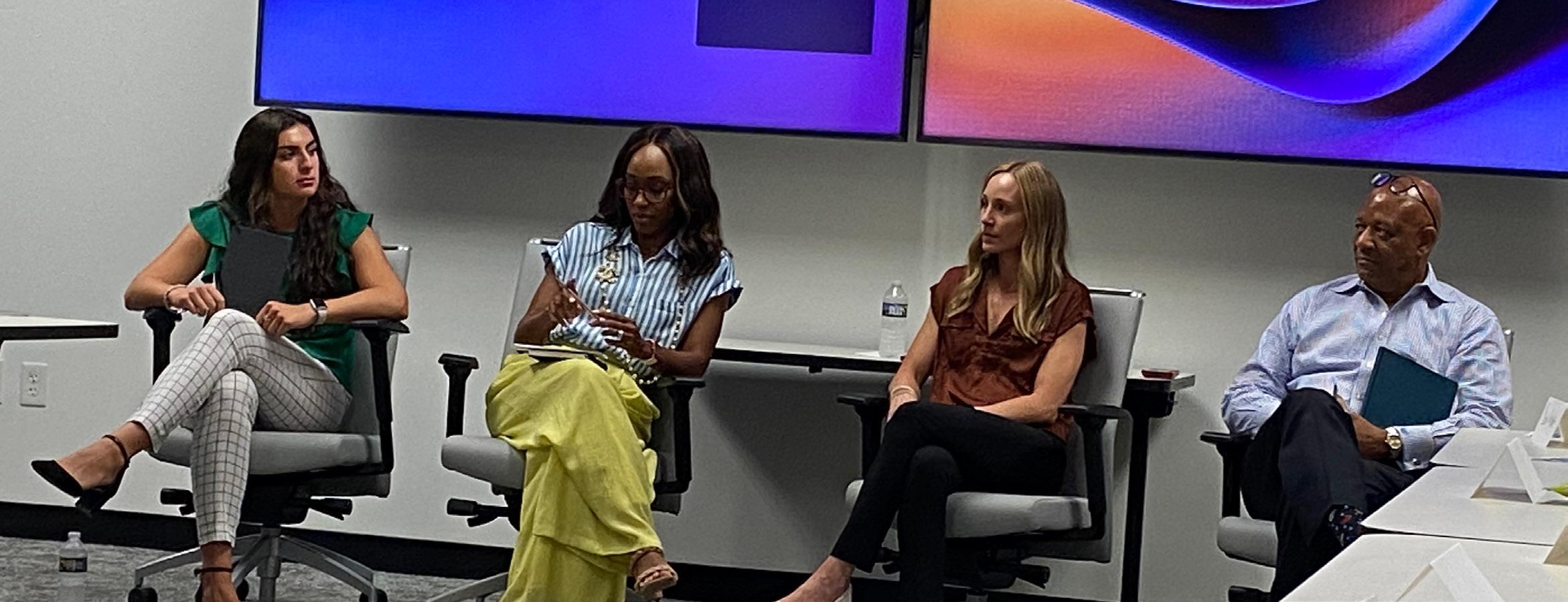

The Novolex Board of Directors is the highest governing body of the corporation with oversight over the company’s policy and programs that address ESG performance. Board members have extensive experience in the global packaging industry, finance, global supply chain and ESGrelated disciplines relevant to Novolex operations and that are applicable to stakeholders. The Board and its committees meet four times a year to evaluate the management of the company and its impact on the economy, the environment and people, and makes recommendations and receives updates on implementation at subsequent meetings.
The Board was established in April 2022 and is currently comprised of nine members, including Board Chairman and CEO Stanley (Stan) Bikulege. Two members of the Board are women. There are three standing committees of the Board: The Audit Committee, The Compensation Committee and The Sustainability & Environment, Health and Safety (S&EHS) Committee.
The S&EHS Committee is responsible for the company’s strategy and performance in all areas outlined in this report, including the company’s results against KPIs that align with the three Novolex sustainability pillars. The S&EHS Committee is comprised of three members of the Board. The committee provides direction on evolving expectations that could affect the company’s awareness of and performance against its sustainability goals and assesses the impacts of ESG projects on stakeholders.The committee meets quarterly to receive updates from the Novolex Senior Leadership Team (SLT), including the Chairman and CEO as well as other company subject matter experts. In 2023, the committee considered a number of topics including stakeholder expectations regarding Novolex participation in the circular economy and product sustainability strategy, efforts to meet the company’s GHG emissions reduction target and employee health and safety programs, among other subjects. The Products, Operations and People and Communities sections of this report provide more information on these topics.
Funds managed by Apollo affiliates acquired majority ownership of Novolex from Carlyle in 2022. Carlyle maintains minority ownership. Both Apollo and Carlyle uphold a strong commitment to advancing sustainability initiatives in their portfolio companies and will continue to support progress across the full scope of our sustainability related initiatives. Some members of management are also owners of Novolex.
The Novolex Senior Leadership Team (SLT) has 10 members, including the Chairman and CEO, the presidents of the Food & Delivery and Performance Solutions business segments, the Chief Financial Officer and other function heads responsible for Technology, Procurement, Human Resources, Legal, Business Development and Corporate Affairs. Together, they are responsible and accountable for identifying and executing projects that advance Novolex sustainability goals. The SLT meets weekly and conducts comprehensive monthly business reviews, where the team discusses topics that include the company’s ESG performance. Additionally, the SLT discusses a range of sustainability topics during other functional and business planning meetings as needed. The Senior Vice President of Corporate Affairs on the SLT coordinates all sustainability initiatives and objectives while also receiving support from colleagues who specialize in areas related to sustainability.
Behaving ethically and acting with integrity are central to Novolex and to our reputation in the marketplace. Novolex policies provide guidance to our employees, management and Board of Directors on how to put the letter and spirit of ethics and integrity at Novolex into practice and ensure compliance regarding specific aspects of our business operations. For example, the company’s Anti-Abuse & Fair Treatment Policy promotes an inclusive workplace at Novolex that upholds the right of employees to be treated with fairness and equity in a safe workplace environment free from discrimination, harassment and retaliation.
The Novolex Anti-Bribery and Anti-Corruption Policy highlights employee responsibilities under relevant anti-bribery laws and company policies and provides the tools and support necessary to identify and combat these risks. The Anti-Trust & Competition Policy identifies employee responsibilities under both relevant anti-trust and competition laws and other applicable policies and provides tools and support to identify and combat risks associated with them. Additional policies are discussed in the People and Communities section of this report.
The Novolex cybersecurity framework is rooted in the U.S. National Institute of Standards and Technology (NIST) Cybersecurity Framework (CSF), a comprehensive set of guidelines and best practices endorsed by industry experts and regulatory bodies. Multiple company policies guide information technology and related company functions that are responsible for safeguarding data and systems. The Novolex Chief Information Security Officer oversees a multifaceted approach to risk management, encompassing proactive threat detection, incident response planning and continuous improvement of security protocols. The Audit Committee of the Board of Directors is provided with progress updates and provides strategic guidance to further strengthen our cybersecurity posture. By adhering to the NIST CSF, we not only fortify our defenses against evolving cyber threats but also demonstrate our commitment to maintaining a robust security posture that meets and exceeds industry standards and regulatory requirements. This proactive stance safeguards our assets and data and thus upholds the trust and confidence of our customers, partners and stakeholders, positioning us as a leader in cybersecurity excellence within our industry.
Since its formation, Novolex has embraced sustainability principles and implemented sustainability practices across its product portfolio, manufacturing sites and among its people and communities. In 2023, we adopted a Sustainability Policy, following review by the S&EHS Committee. We decided to publish a policy on this key topic to demonstrate our commitment at the highest level to address ESG expectations of our employees, customers and suppliers as well as those of the diverse communities with whom we interact. Each year, our sustainability report documents and communicates our progress toward fulfilling commitments outlined in the Sustainability Policy.



Across the Novolex product portfolio, we take a holistic view of the total lifecycle of our products, from the selection of raw materials and product design to the impact of manufacturing on the environment to the ways our products can be used and disposed of. Our innovation teams address a range of functional requirements and sustainability objectives that meet the needs of our customers and their consumers. In partnership with our suppliers and customers, we strive to identify raw materials and product designs that offer balance between societal needs, GHG emissions and product disposal.
Novolex continues to enhance our capability to provide product-level carbon data to support customer purchase decisions. Our strategy is to use this information to support raw material selection and product design decisions in the major end-markets we serve. The process is improving our understanding of emissions generated at different stages of the supply chain, putting Novolex in a position to have strategic conversations with customers about how our products support achievement of their carbon reduction goals.
Novolex uses the ISO 27001 certified Trayak EcoImpact COMPASS sustainability platform, designed to prepare product lifecycle analyses (LCAs) to quantify the benefits or impacts of different raw materials and product design decisions. These calculations rely on industry-leading lifecycle inventories to estimate the carbon impacts of packaging and other products. Trayak EcoImpact COMPASS also conforms to ISO 14040 and 14044.
An important factor in product carbon footprint analysis is the inclusion of carbon uptake in the boundary for products made with renewable resources. Carbon uptake reflects the concept that plants and trees absorb, or sequester, carbon during their growth. Through the product’s lifecycle, some of this carbon remains in the soil after harvesting or can return to the soil at the time of the product’s disposal, leading to reduced carbon footprint. Depending on the methodology used for the LCA analysis, the accounting for this phase can vary. Consequently, Novolex and our customers must make decisions about how to evaluate the full lifecycle of products. We are tracking these developments closely and have been using them to inform and provide customers with a perspective on the impact that carbon uptake can have on the analysis of a product’s carbon footprint. As the need for consistent and reliable data increases among customers and other stakeholders and as climate science evolves, Novolex will continue to use tools, such as EcoImpact, as well as collect primary data, to drive progress toward accurate and complete product carbon footprint data.
We fulfill the Novolex brand promise to provide customers with choice, innovation and sustainability starting with our selection of raw materials. Over the years, Novolex has supported emerging customer needs by continuously expanding the types of materials we use in our product lines.
In 2023, 47% of Novolex raw materials came from renewable, bio-based or PCR sources.
In 2022 and 2021, this figure stood at 49%. This 2% shift was due to changes in our production mix. Our raw materials include multiple bio-based resins, PCR paper and resins, virgin resin and paper, aluminum, sugarcane (bagasse), wood, bamboo and more. We are at the forefront of using bio-based resins and renewable materials in a growing number of products.
Given the wide variety of materials used for our products, we are committed to staying informed about global sustainability developments that apply to our operations and business. In 2023, reducing reliance on fossil fuels and ending deforestation were two topics at the forefront of the 28th United Nations Conference of the Parties Climate Summit (COP28).
At COP28, over 200 diplomats approved a global pact that emphasized the transition away from fossil fuels that contribute to climate change, which was the first time fossil fuels have been explicitly mentioned. In addition to reducing fossil fuel reliance, COP28 outcomes included calls for deforestation commitments, specifically ending deforestation in the tropics and reforestation financing for developing countries. Novolex recognizes our responsibility to understand and identify opportunities we may have to address commitments that emerge from the conference. We will continue our efforts to measure and evaluate options for raw materials, placing increasing emphasis on carbon data to guide our offerings and recommendations to customers.

Provide customers with packaging solutions using a range of designs, materials and functionality
Develop and adapt products that meet evolving customer and market driven needs
Promote the use of packaging materials and designs that support the circular economy

Bio-based resins such as polylactic acid (PLA) and polyhydroxyalkanoate (PHA), also called bioplastics or bio-resins, are polymers derived from plants like corn and sugarcane. They provide the packaging industry and our customers with a renewable and often compostable option that features many of the same performance benefits as conventional resins derived from fossil fuels. Novolex is engaged in testing the limits of these resins as the market demand for renewable, compostable and bio-based alternatives continues to grow. We can now use these materials in several of our facilities to produce hinged containers, cups, straws, can liners and produce bags.

In 2022, we announced a $10 million investment to increase recycling capacity at our North Vernon, Ind., recycling facility. Following the investment, in 2023 we made a commitment to double the volume of post-consumer polyethylene (rPE) films that we recycle in North Vernon, Ind., by the end of 2024. We look forward to sharing progress towards this commitment in our 2024 Sustainability Report.
In 2023, we announced a collaboration with NOVA Chemicals to operate a new plastic film mechanical recycling facility in Connersville, Ind., which will bring 125 jobs to the community. We will bring our extensive experience—we operate two film recycling facilities of our own—to produce 100 million pounds of rPE for the market under NOVA’s SYNDIGO™ brand. The project will divert plastic film from landfills and demonstrate the viability of plastic recycling, reflecting our shared commitment to support recycling and the circular economy.
The NOVA Chemicals logo is a registered trademark of NOVA Brands Ltd.; authorized use. SYNDIGO™ is a trademark of NOVA Brands Ltd.; authorized use.

In 2023, 23% of total purchased resin by volume included recycled content from both PCR and post-industrial recycled sources. Our total PCR volume increased to 4% of total resin in 2023, driven largely by increased PCR utilization in Waddington North America, our North American rigid plastics business. Bio-based resins in the Novolex portfolio remained at 2% of our total resin sourcing volume.

2023 Resin Sourcing















Novolex seeks to optimize the use of paper that is ethically sourced from well-managed forests. Consistent with that goal, more than 99% of the paper we purchase comes from paper suppliers who are certified by one of the internationally recognized forestry certification programs managed by the Forest Stewardship Council® (FSC®), the Sustainable Forestry Initiative® (SFI®), or the Programme for the Endorsement of Forest Certification™ (PEFC™).








In 2023, 14% of our virgin fiber volume was also certified Chain-ofCustody by one of the certifying organizations. Chain-of-Custody fiber is traceable back to forests that meet sustainability requirements such as requiring that forests are replanted after harvesting and that fair labor practices are utilized to support the rights of workers. Because Chain-of-Custody certified fiber represents a higher standard for sustainably sourced virgin fiber, we separate it in our reporting. This year we report the percentage of Chain-ofCustody fiber as a percentage of all virgin sourced fiber. Most of the PCR paper we purchase also is certified FSC® Recycled 100% SA-COC-013255, which designates Novolex products made with recycled paper as recycled Chain-of-Custody certified. However, we do not report those volumes because the custody chain is more important when dealing with virgin harvested fiber.
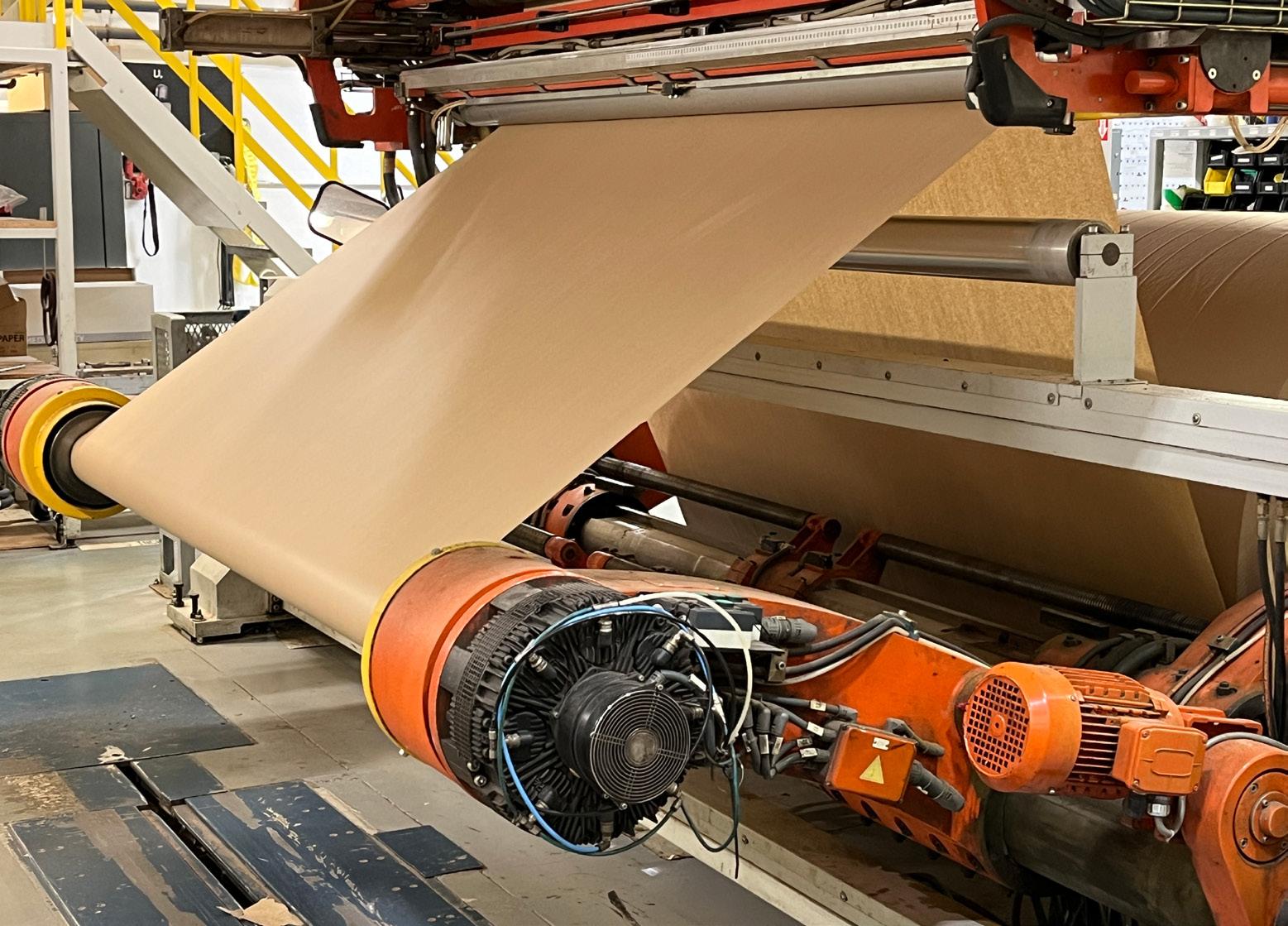
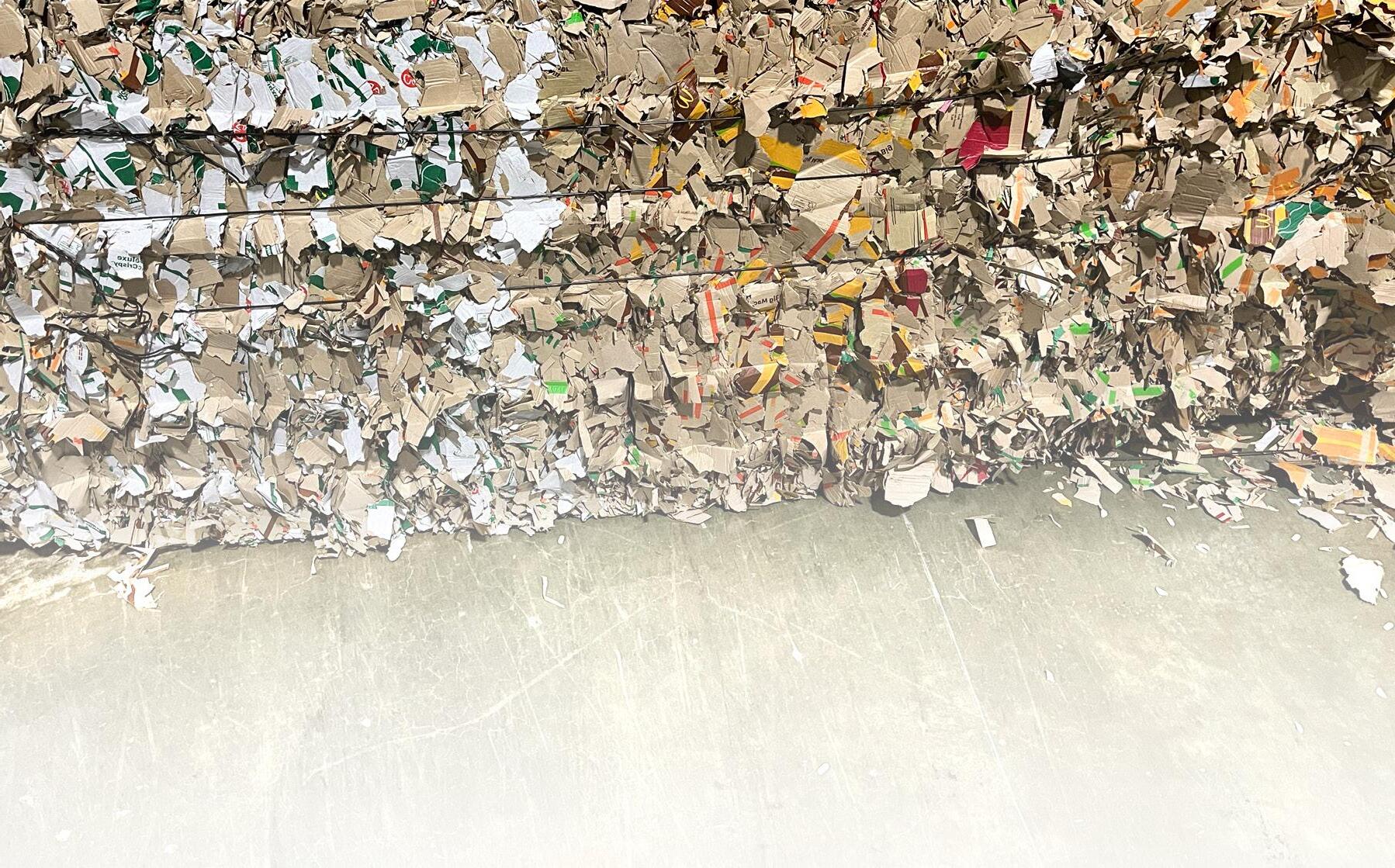
In our businesses that use paper we saw an increase in the utilization of PCR paper to 52% in 2023 compared to 49% in 2022. 52%


Novolex seeks to continue its efforts to provide food packaging that can facilitate food waste diversion away from landfills, as food waste is one of the largest contributors to global methane emissions. Novolex continues to obtain commercially compostable certification across our portfolio of products to assure our customers and their consumers that applicable products meet industrial composting standards and can be composted at commercial facilities. Our New Product Development teams partner with customers to design products for commercial composting and advise on the best methods of sortation and labeling to educate consumers.
The range of certified compostable products available in our portfolio has increased markedly in response to demand from our customers and their consumers. A growing number of Novolex products are made from molded fiber, a raw material category derived from materials such as bamboo, wheat straw, miscanthus and bagasse, which is derived from sugarcane pulp. Our Eco-Products and Vegware businesses, both of which are leading suppliers of compostable foodservice packaging around the world, use molded fiber to develop compostable products. Not only are all these raw materials a renewable resource, but by using the by-product of sugar production, we also help reduce waste.
To optimize composting for its compostable products, in 2023 Eco-Products introduced a voluntary composting program called Controls Intended to Remove Contamination (CIRC). The program helps ensure that restaurants that use compostable plates and other tableware take specific steps to avoid mixing non-compostable items with compostables. While food scraps and certified compostable packaging can be composted, anything else that accidentally goes into a waste bin that is supposed to be dedicated only for composting can contaminate the compost and create challenges for composters. CIRC is a collection of free, open-source resources to improve composting systems by keeping contaminants out of restaurant waste streams destined for composting. Foodservice operators do not need to be Eco-Products customers to use or benefit from the program.
In 2023 Eco-Products introduced Veridian™, a line of cups, lids, containers and cutlery designed for jurisdictions that would require food packaging to be clearly marked as compostable starting in 2024. All Veridian packaging is clearly marked with the word “Compostable” and uses green or brown tinting and striping that further distinguishes it from non-compostable counterparts. The design makes it easier for consumers, composters and the entire foodservice value chain to differentiate between compostable and non-compostable products and also meets emerging U.S. state labeling requirements for compostable packaging that went into effect in 2024. Veridian products have been certified compostable by the Biodegradable Products Institute and display the Biodegradable Products Institute (BPI) certification accordingly.

CIRC
Systematically control and mitigate contamination from non-compostable materials
Increase composter confidence in organics streams that contain post-consumer food scraps and certified compostable packaging
Demonstrate that a systems approach to contamination mitigation is possible in an array of foodservice environments
In 2023, applicable Novolex revenues from products that were recyclable, compostable or reusable grew to 84%, an increase of 6% compared to 2022. The increase reflects ongoing efforts across the Novolex portfolio to innovate products for recycling, composting and reuse. Additionally, the increase was driven in part by a recategorization of additional durable goods which are not included in scope of this metric[1].
To measure revenues from our North American products that can be recycled, we utilize How2Recycle® definitions managed by the Sustainable Packaging Coalition. Those classifications include “Widely Recyclable,” “Check Locally,” “Store Drop-off” and “Not Yet Recyclable,” which are guided by the U.S. Federal Trade Commission and Canadian Competition Bureau. For our European products, local regulatory agencies provide definitions based on the availability of collection and processing infrastructure. All compostable or reusable products must obtain third-party certification, such as certification as compostable by BPI, or have been tested to verify performance consistent with accredited industry standards. As we move forward with reporting this metric, we will continue to monitor regulatory guidance emerging from around the world to guide our classifications.
1 A share of Novolex products are excluded from the scope of the SASB metric because they do not appropriately classify as recyclable or compostable. Examples of these products include trash can liners and materials used to manufacture products used in construction and other durable applications. These products make up approximately 16% of Novolex revenues.









In 2023, our Waddington® North America business that produces rigid plastic foodservice packaging introduced containers that are both recyclable, where facilities exist, and made with a minimum of 10% PCR content. The new products include Signature brand dessert cups, CakePak™ brand bases and lids, BreakAway™ tamper-evident containers and multi-use clamshells.



Novolex introduced new variants of the popular ProWAVE® Tote bag, a recyclable, reusable tote that simplifies deliveries and carry-out for supermarkets, restaurants, retailers and their customers. To comply with packaging regulations that impact our customers in applicable U.S. states, we now offer a version made with 2.25 millimeter gauge film that comprises at least 40% PCR content and enhances reusability.

Waddington® Europe continues to produce soft-fruit punnets using patent pending MONOAIR™ cushion technology, made from 100% recycled polyethylene terephthalate (rPET). The cushion padding is integrated into the body of the container and facilitates recycling by not having separate bubble padding that is not recyclable and must be removed. Instead, the integrated cushion enables the entire container to be recycled back into food-grade rPET.



In 2023, Duro® paper shopping and lawn and leaf bags earned BPI certification. The new certification complements our efforts to provide environmentally responsible packaging options for customers and product users, enabling more individuals to lower their landfill contribution whether by recycling or composting.

Our Eco-Products brand added two new sets of lids, one for paper hot cups and the other for molded fiber ovals, rectangles and bowls. The new sets of lids are part of their Vanguard™ products made with renewable molded fiber, are BPI-certified compostable and do not contain intentionally added per- and polyfluoroalkyl substances (PFAS). These new products join existing GreenScreen Certified™ Vanguard products that do not use intentionally added PFAS or contain other chemicals of high concern.


Eco-Products new compostable cutlery, made from Forest Stewardship Council® (FSC)® certified birch wood, has also received a 100% biobased score from the USDA BioPreferred® program, which assures consumers that the product contains a government-verified amount of renewable biological ingredients.

In October 2023, the Portland Trail Blazers and Eco-Products announced a partnership that names Eco-Products as an Official Zero Waste Partner of the organization. The Trail Blazers join Vail Resorts, the University of Colorado, Red Rocks Amphitheater and other high visibility waste-diverting organizations in demonstrating that organics diversion at scale is possible when the right procurement, communications and waste-sorting processes are in place. These partnerships, and the many other examples from across its customer base, help Eco-Products make the case to the foodservice industry that using compostable products as a mechanism for keeping food waste out of landfills is within reach for all.
Eco-Products is also providing the reusable cups at the Moda Center, the Trail Blazer’s arena in Portland, with a groundbreaking reusable drinkware program, which marks the first-ever full venue reusable packaging program associated
with professional sports in the U.S. Guests who purchase alcoholic beverages in the arena will receive Rip City Reuse branded reusable drinkware, which can be returned to designated bins throughout the arena. The cups are manufactured by Novolex’s Waddington North America business and are cleaned, sanitized and returned for reuse at the arena.
The opportunity to provide reusable cups in Portland reflects a growing interest among foodservice customers to use reusable products to support sustainability goals. Importantly, our ability to provide reusable products is another way we fulfill the Novolex Brand Promise to provide choice alongside innovation and sustainability, which are key to the Novolex business strategy. This effort has led to partnerships with different organizations that are leading the way in reuse systems.


As a whole, investments in reusables reflect the Novolex commitment to offer our customers an ever-broader choice of more sustainable packaging for different settings. Reusables are a great fit alongside our other products that can be recycled or composted. There is still much to be learned from reusable packaging and reuse systems, and Novolex aims to be at the forefront.
“
Paul Frantz, President, Food & Delivery

In 2024, Novolex announced a strategic investment in Rhode Islandbased reusable systems and container brand OZZI®. The OZZI family of products and solutions includes containers equipped with bar codes that track O2GO® containers, cups and cutlery. These work with OZZI Drop N’Go Collection Systems and other equipment to support collection, washing, sanitizing, drying and storage of returned reusables. OZZI products and solutions are specifically designed for closed-system environments such as colleges and universities, corporate campuses, military bases and hospitals. When OZZI containers can no longer be reused, they are recycled. U.K.-based Vegware™, a sister company of Eco-Products, and Eco-Products divisions in Canada and Europe will have access to the full array of OZZI products and solutions to help accelerate global demand for these solutions.
Novolex advocates for responsible legislation, regulation and standards that support communities and the packaging sector with a stable, transparent and accountable marketplace. In 2023 we saw ongoing and new policy discussions focused on recyclable and compostable labeling and claims standards, PCR content standards, Extended Produer Responsibility (EPR) and other waste and resource themed policies.
As a leader in sustainable packaging, Novolex is ideally positioned to capture and understand the perspectives of consumers, operators, distributors, composters, recyclers, raw material suppliers and others in the value chain. This has made us a recognized thought leader and resource for policy makers, regulatory agencies, community leaders and others seeking to create better end-of-life options for packaging. The focus of these engagements is the creation of well-crafted policy that improves the recyclability and compostability of packaging and increases access to, and the performance of, recycling and composting infrastructure. Novolex invests in trade association partnerships that conduct research, develop scalable pilot programs, provide grants to recycling centers and conduct consumer outreach that are focused on recycling and composting. Novolex also participates in regulatory agency workshops and working groups where our technical experts provide government bodies with knowledge and counsel.
Additionally, as new policies emerge, we communicate and work with our customers and other partners to develop compliant products that support these policy initiatives once adopted. Examples include product lines that aligned with compostable labeling standards in Washington state and Colorado, can liner (trash bag) lines that supported PCR content laws in New Jersey and Washington state at the end of 2023 and other regional initiatives.

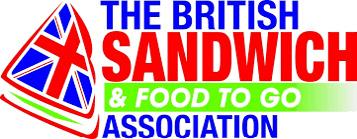


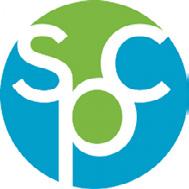




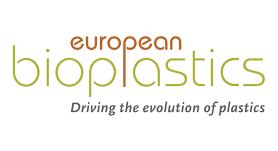
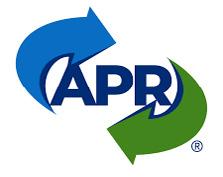

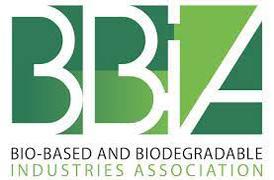




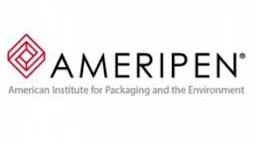
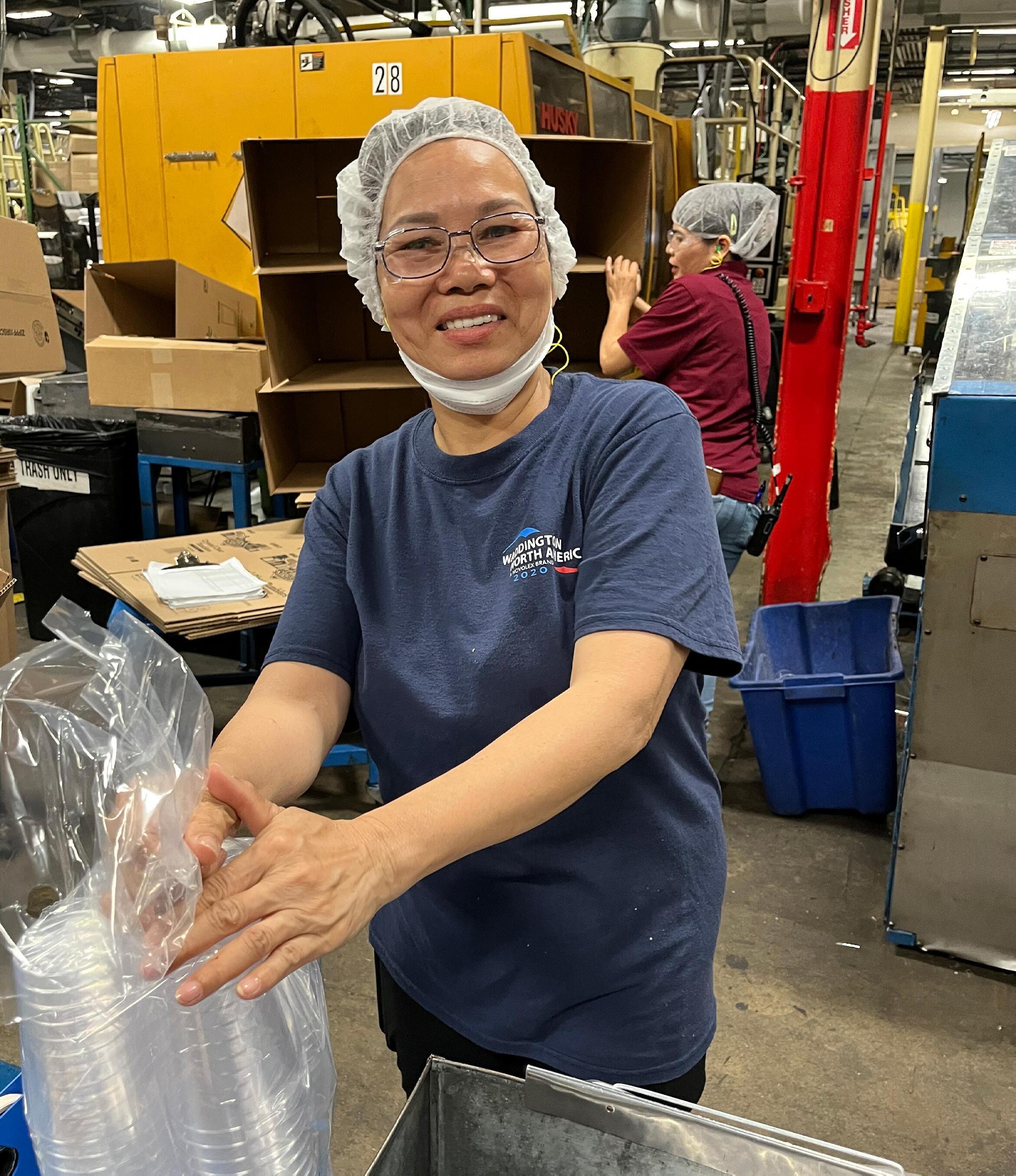

Novolex prioritizes environmental stewardship and awareness among all members of the Novolex family. We believe Novolex has a responsibility to reduce our impact on the environment across our manufacturing operations. We strive to reduce our environmental footprint and make measurable performance improvements by creating a culture within our operations that drives change. Our environmental efforts, performance and progress are measured by our increasing number of operational KPIs focusing on emission reductions, energy efficiencies, waste reduction and more.

In 2023, Novolex continued our commitment to reducing GHG emissions from manufacturing. Our manufacturing sustainability programs remain an area of emphasis for Novolex to reach our goal of a 30% reduction in global emissions by 2030. We are pleased to share continuing progress towards our target.
Novolex recognizes its role in supporting the mitigation of climate effects from the escalation of global temperatures, sea level rise and extreme weather events. We established a companywide baseline for our global emissions in 2019. This baseline has since allowed us to set targets focused on achieving measurable progress and locate improvement opportunities. Our planned investments in energy efficient technologies now includes a broad range of projects in our plants. Some examples of these projects include LED lighting, HVAC, chiller and boiler replacements, compressed air optimization, thermal insulation to retain heat, as well as replacing major production equipment with new, more efficient options. We also continue to support the future of the renewables market with Renewable Energy Credits (RECs) and Power Purchase Agreements. The combination of these efforts put us on track to reduce our carbon footprint in line with our target. Additionally in 2023, product mix variations and continued investments in energy efficiency led to an overall decrease in Novolex energy use.
Novolex Target: Achieve a 30% reduction in global emissions per ton of production by 2030.
This target is tied to KPIs outlined in our sustainability-linked financing which requires that Novolex must achieve annual progress that is assured by a third party to renew discounts on our debt financing.





























Energy use has a significant impact on Novolex emissions at our manufacturing facilities. The following potential sources of emissions also exist within Novolex: use of propane and gasoline for mobile combustion, refrigerant leaks and use diesel generators at a subset of Novolex facilities. In the aggregate, according to the GHG Protocol, these minor emission sources are immaterial relative to the measured Scope 1 and 2 footprint and have been excluded from our emission data. We may prioritize collection of this data in the future, particularly as we continue to monitor SEC disclosure requirements.
Novolex also underwent a GHG verification process to ensure our Scope 1 and 2 GHG emissions, total energy consumption and emissions intensity metrics were calculated and reported accurately. Receiving limited assurance allows Novolex customers and employees to trust our progress toward our 2030 emission reduction target, and rely on our data for tracking progress against our annual KPIs.
Our 2023 strategy focused on initiatives to create operational efficiencies and reduce our reliance on RECs in alignment with our target. Novolex brought in Redaptive, a leading energy consulting firm, to audit 11 facilities, with plans to conduct additional energy audits in 2024. Facilities were prioritized based on their overall energy use, as well as location. Specifically, we audited many of our facilities that are located in geographies where emissions per kilowatt-hour are higher. The results from this analysis will be used to inform and optimize the ways we will reduce emissions.

While we continued to reduce our Scope 1 and 2 emissions throughout 2023, Novolex also progressed with our comprehensive Scope 3 GHG inventory. Over the past year, we have continued to identify our material Scope 3 categories and estimate their relevancy to our overall Scope 3 carbon footprint. We have mapped out the approximate percentage each Category contributes to our Scope 3 footprint and Novolex will continue our efforts to develop a complete Scope 3 inventory in alignment with the GHG Protocol. Novolex remains focused on these objectives as they align closely with the future sustainability of our industry and expectations from our customers and other stakeholders. For more information, see new disclosures on page 7
Novolex GHG reduction objectives align with those of many of our customers, who seek suppliers that share their sustainability goals. We meet our customers’ increasing needs by providing third-party verified allocated emissions data from our operations as well as estimates for products through software-based Product Carbon Footprint (PCF) analysis. This information is becoming increasingly important to our customers as they assess their own Scope 3 emissions including tracked supplier emissions. Novolex aims to be ahead of the curve in supporting our customers with data.
Redaptive is proud to partner with Novolex to strategically accelerate their GHG reduction. Together we have identified multiple projects across solar, mechanical and lighting throughout the Novolex portfolio. Redaptive will fund these projects upfront, allowing Novolex to retain their CapEx for business growth opportunities. Additionally, our Redaptive One platform will track savings and provide validation for every project. We are thrilled to partner with Novolex.
“
Colin Sturtevant, Director, Sustainability Solutions at Redaptive

Novolex is prioritizing the conversion of older forklifts to newer, more efficient models. In 2023, Novolex identified a fleet of 17 forklifts in Erlanger, KY, our largest warehouse, and replaced them with electric models. According to our vendor partner, in one year, the transition from liquid propane gas to electricity has eliminated almost 21,000 pounds of carbon emissions per vehicle and over 356,000 pounds of carbon emissions for the full fleet.

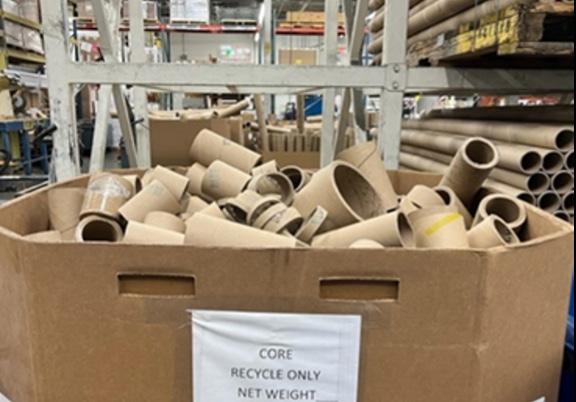
Novolex is advancing monitoring and data collection efforts across various areas of operations. To promote clean air, waste reduction and optimized water use in our operations. Novolex has devoted attention to managing and tracking processes and materials used throughout our operations and in our products. The Novolex Director of Environmental Compliance oversees all operational impacts across 55 manufacturing sites. Novolex identifies air, waste and water impacts specific to each facility and develops action plans to mitigate environmental impacts in partnership with local environmental, health and safety (EHS) managers. In 2023, the Novolex Waste Core Team made progress measuring our waste footprint, with additional data now available to support a more comprehensive view of the type of waste being produced at Novolex locations and whether it is being recycled, composted, incinerated (with or without energy capture) or landfilled. Additionally, we prioritized an assessment of our facilities using the World Resources Institute’s (WRI) baseline water stress tool.

At Novolex, we monitor our air emission permits, focusing on nitrogen oxides (NOX), sulfur oxides (SOX), volatile organic compounds (VOCs), and particulate matter (PM). Emissions released by Novolex facilities vary depending on their specific processes. VOC emissions commonly arise from the use of inks for product printing, while NOX and SOX emissions result from the use of natural gas during operations. We also use some propane and account for that usage in the table to the right. In 2023, we expanded the scope of our air emissions reporting to include our Rio Bravo, Mexico facility and took steps to further quantify Scope 1 emissions which are not considered material, such as those that result from use of propane and diesel fuel. While we do not use a large volume of these fuels, we recognize the importance of understanding our usage.
Managing waste responsibly is imperative to Novolex and we recognize that everyone has a role in waste reduction and landfill diversion. In 2023, we expanded our cross-functional Waste Core Team and continued to work towards a comprehensive zero-waste-to-landfill program to enhance our monitoring and reduction of different waste streams. Throughout the year, the team collaborated with Operations staff and visited facilities to identify additional waste reduction opportunities. Our waste data now also includes our Canadian facilities, which were excluded from last year’s data. In total, Novolex generated approximately 75,000 metric tons of waste in 2023, the majority of which was recycled.






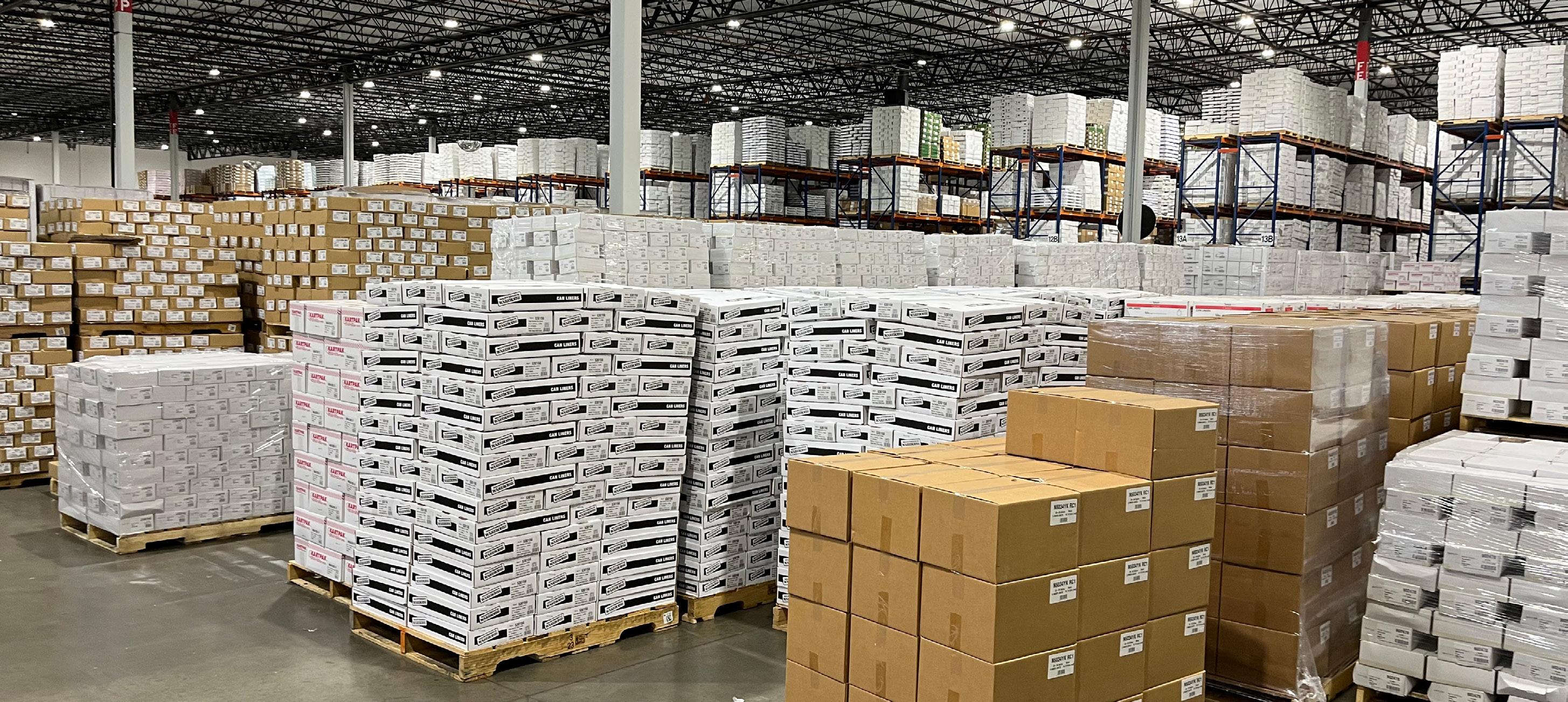
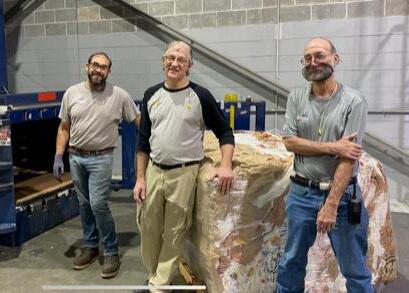
“Bale It—Forever… Dump It—Never!!”
During the first three months of 2023, our Bagcraft packaging plant in Baxter Springs, Kansas started with an average of 63.45 tons of trash per month. After noting the high volume of trash coming from this plant, Novolex’s waste partners at Casella visited Baxter Springs to provide recommendations on ways for the plant to reduce its trash volume and decrease its impact on the environment. During the visit, plant workers were advised to bale the brown waxed paper. Compacting the scrap waxed paper into bales would make it easier for recycling plants to accept and recycle the material.
After incorporating this strategy into their waste management process, the Baxter Springs plant saw a decrease in trash volume to an average of 41.86 tons per month, a more than 30% decrease over prior years. After the plant visit and to formalize the program, the plant created a campaign called “Bale It—Forever…Dump It— Never!!”. This programming demonstrates how Novolex employees get involved with sustainability initiatives at the local level and improve environmental outcomes due to their individual contributions.

Each year Novolex waste partner, Casella, a leading environmental services provider, selects a few of their customers to receive an annual Casella Sustainability Leadership Award. Novolex was selected as a 2024 award winner for its leadership, innovation and collaboration in reducing waste and advancing the circular economy. The award recognizes companies creating a better tomorrow by showcasing each recipient’s sustainable material management practices. Recipients are selected from a range of segments, including municipalities, colleges and universities, industrial manufacturers, food and beverage producers and more.
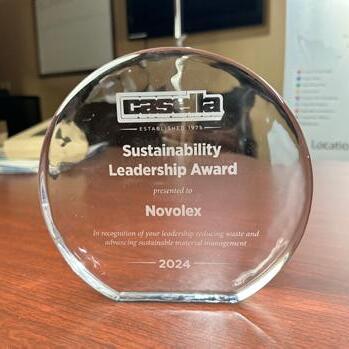


The Novolex Bagcraft team in Norcross, Georgia developed and implemented processes designed to increase overall recycling activities throughout the plant. These efforts included better defining the various waste streams, segregating specific substrates, minimizing mixed bundles and shipments and assigning dedicated personnel to manage the program across all shifts to ensure compliance and success.
As a result, over 170 tons of waste material were removed from the yearover-year totals in the second half of 2023, and that number is expected to double in 2024. The Norcross team takes great pride in supporting these efforts as part of their contribution to their local community.
Novolex generates a small amount of hazardous waste, representing less than 1% of our total waste footprint. We ensure proper management and tracking of hazardous waste to protect the safety of the people, communities and environments that surround Novolex operations.
Depending on the volume of waste generated and regulatory requirements, some Novolex facilities must maintain proper management, tracking and monitoring of hazardous waste generated onsite. In facilities that generate hazardous waste, Novolex conducts initiatives, including solvent capture and reuse programs, to promote hazardous waste reduction.
We aim to provide a comprehensive overview of the Novolex hazardous waste practices as we develop broader waste metrics and gather additional data on our current management approach.
To enhance our waste reduction and landfill efforts, Novolex maintains strong partnerships with Casella Waste Systems, Roadrunner Recycling and Valpak. These partnerships support implementation of landfill diversion strategies.
Our Waddington Europe business has been zero-waste certified by waste partner, Valpak, since 2020.

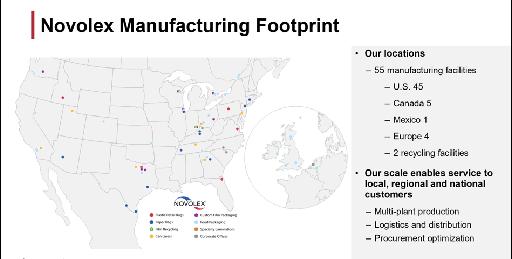
the U.K. and the Netherlands


To meet the requirements of our diverse customer base, our commitment to food and product safety starts at the highest levels of leadership and resonates throughout the organization. Our customers expect our products to meet stringent globally recognized standards required for all materials that come into contact with food. With a vision of safe food for consumers everywhere, 2,000 food industry leaders created the Global Food Safety Initiative (GFSI) to reduce food safety risks and build trust throughout the supply chain. GFSI drives continuous improvement in food safety management systems around the world. For more information about food and product safety at Novolex, see our Food Safety webpage.

Novolex has 40 facilities certified to GFSI recognized standards.





Investing in our Novolex family and the communities in which we operate is central to our values. We remain committed to creating a workplace where safety, ethical conduct, inclusivity, health and well-being and community support are at the forefront.

40% women or people of color made up 40% of our top 60 leaders. (U.S. and Canada only)

26% women or people of color made up 26% of our plant managers. (U.S. and Canada only)


Safety is not just a value at Novolex. It is a cornerstone of our business that is woven into our daily operations and guided by the Novolex Safety Handbook. Whether on the production floor of our manufacturing facilities or among colleagues in an office, it is always a priority to provide a safe working environment for everyone. Novolex workplace safety programs and procedures constantly seek to go beyond reinforcing existing practices, and in 2023 we continued to explore and implement new ways to enhance safety performance across the company. The Novolex Health and Safety Management System supports these initiatives, tracking policies, processes, procedures and performance. The system efficiently manages inspections and incident investigations and prescribes both corrective and preventative action plans. The Sustainability & Environment, Health and Safety Committee of the Novolex Board of Directors reviews safety performance and program progress every quarter, ensuring our commitment to safety is evaluated by our highest governing body.
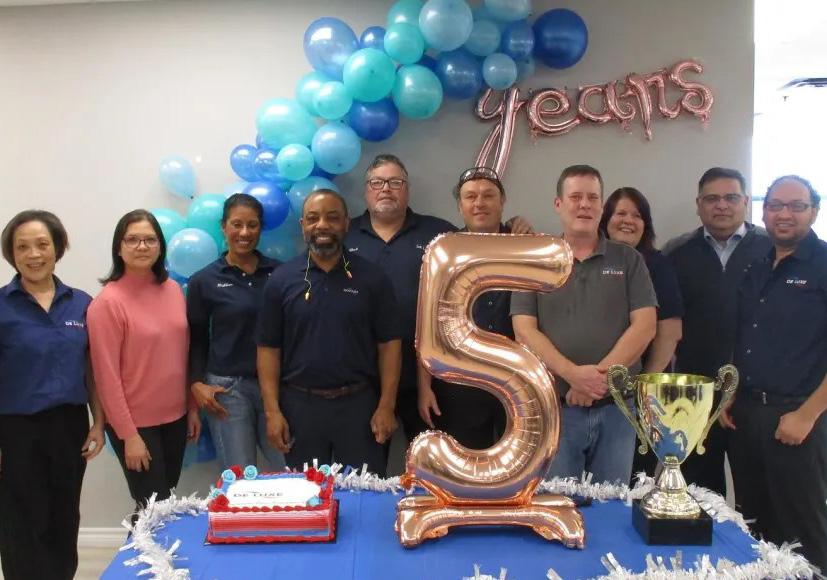
Novolex maintains a Total Recordable Incident Rate (TRIR) below the industry average, based on Occupational Safety and Health Administration (OSHA) guidelines and Bureau of Labor Statistics data. In 2023, we observed an increase in safety incidents, with a TRIR of 2.30, compared with a TRIR of 2.06 in 2022.
While we focused efforts in 2023 on improving safety by applying safety strategies shared by some of the most safety-forward companies in our industry, we continued to face challenges due in part to production staff turnover.
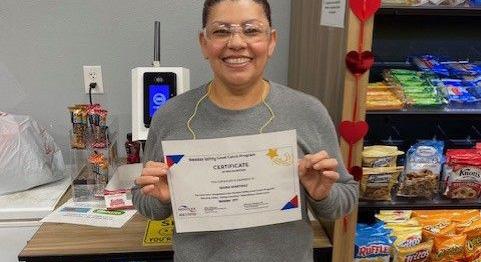
1 U.S. Bureau of Labor Statistics
Safety permeates every aspect of our operations and is focused on the well-being of employees, contractors, customers and communities. Safety teams have been established, and investments made in processes to minimize risk and the potential for incidents. Over 120 Novolex family members spearhead our health and safety programs. At the facility level, Novolex employees are encouraged to approach each day with a “safety always” approach. By keeping safety top of mind, employees can share best practices that allow Novolex to put defenses in place and evaluate what risks and hazards are present. Together, we cultivate a proactive, blame-free safety culture centered on continual learning and communication.

We encourage workers to report work-related hazards through various channels, including during regularly scheduled plant safety committee meetings as well as anonymously through suggestion boxes in each facility and through the Novolex Ethics and Compliance Hotline. Monthly Safety Committee meetings at each facility, involving both management and production floor employees, provide a platform for direct communication. Our open-door policy empowers employees to freely express safety concerns one-on-one with their supervisors, ensuring a voice for change without fear of reprisal. Additionally, employees can report hazards during safety committee meetings and receive regular safety training, toolbox talks, assessments and other communications to maintain a safe workplace. Our commitment to open communication without fear of reprisal is backed by the Novolex Ethics and Integrity Speak-Up Policy.
To further engage colleagues on the production floor, in 2023 we introduced our “Good Catch” program. The program encourages employees to share near misses, propose areas for improvement and nominate colleagues for recognition when they coach others or witness exceptional efforts in making the workplace safe.
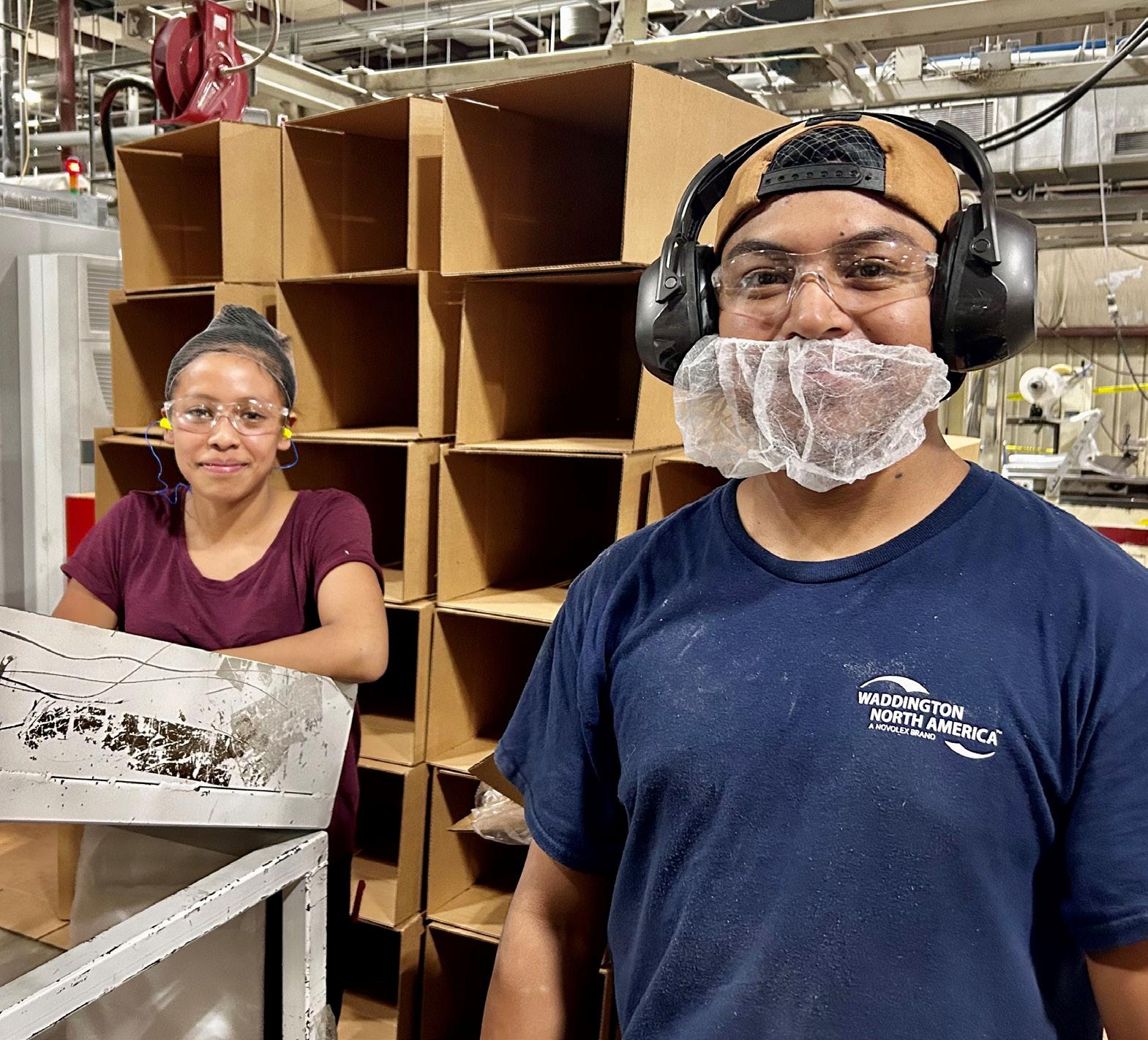
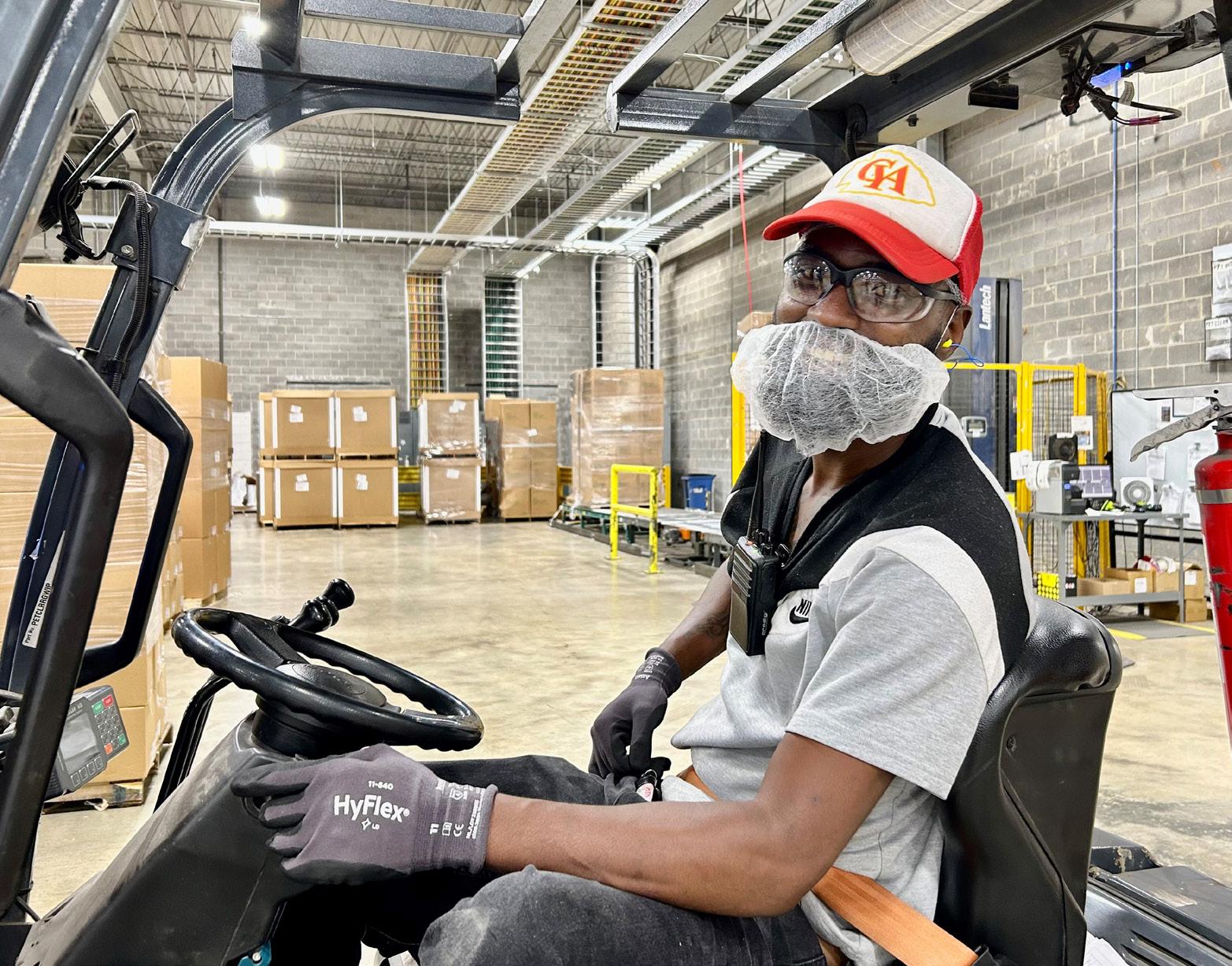
In 2023, we continued to transform the organization through our Human Performance (HP) journey. The use of HP principles introduces a novel approach to safety, which involves understanding the interactions between people, culture, equipment, processes and systems. This includes implementing defenses to prevent incidents, reduce risk and enhance our safety culture. In 2023, we added an EHS Training Manager to our safety organization to develop our own HP training materials and tools. Monthly HP Champion virtual meetings provide opportunities for our plant managers and their safety professionals to share best practices. Our next safety perception survey is scheduled for 2024.
7,000
On site, we conducted over 7,000 hours of HP training across the organization in 2023.
The core of all safety programs revolves around reducing and eliminating risks while equipping employees with the necessary tools, training and resources for safe job execution. In addition to HP training, employees participate in safety training using courses available in the Novolex University Learning Management System, “toolbox talks,” shift safety meetings, onboarding sessions for new hires, refresher courses and site-specific training. Plant leadership teams conduct Gemba walks, audits, periodic risk assessments and other methods to identify and mitigate potential hazards in both production and distribution facilities.
This past year, Novolex also implemented Event Learning Teams and Operational Learning Teams to help conduct safety audits and evaluate processes to supplement traditional safety incident investigations.

People are imperfect, and even the best make mistakes Organizations and people drift


Events can be avoided by learning; how you respond to failure matters 1 4 3
Individual behaviors are influenced by culture and leadership
People achieve high levels of performance based on encouragement and reinforcement; blame fixes nothing Error-likely situations are predictable



Novolex strives to uphold the highest ethical standards for business conduct throughout the entire organization and within our supply chain. We clearly document and communicate our expectations for ethical business conduct through our employee and supplier codes of conduct and related policies, programs and procedures.
The Novolex Employee Code of Conduct rests on seven principles that establish clear expectations for employee behavior and serve as the foundation for the company’s requirements for ethical business conduct. All new hires are required to read and sign an acknowledgment indicating their understanding of, and agreement to abide by, the code. Additionally, every employee must annually acknowledge and agree, by signing, to abide by the code. In 2023, 96% of all employees completed the annual recertification process.
Novolex encourages employees to communicate openly about operations, safety and compliance issues. No one knows Novolex better than the 10,000 members of our Novolex family and we urge them to share their insights and ideas on how we can improve our performance every day by operating more safely and efficiently, improving product quality, reducing energy use and so much more. Handbooks for both salaried and hourly employees explain our open-door approach to communications and encourage colleagues to speak up in production team shift change meetings, one-on-one with supervisors, with Human Resources representatives, or others. We recognize, as well, that sometimes employees may have concerns about the workplace that they do not feel comfortable raising with the leadership team members where they work. The Novolex Ethics & Integrity Speak-Up Policy[1] provides the framework for reporting such concerns through the Ethics and Compliance Hotline, which can be used by employees to voice concerns. The policy assures that calls or emails to the hotline are received and assessed in confidence. The policy prohibits retaliation against employees who use the hotline in good faith to ensure that they can feel comfortable expressing concerns. Posters advertising the hotline and how to use it are displayed in all company facilities.
1 The scope of the Novolex Ethics & Integrity Speak-Up Policy incorporates provisions that may be found in so-called whistleblower policies or those with similar names intended to provide confidential reporting. The Novolex hotline is also available to suppliers.







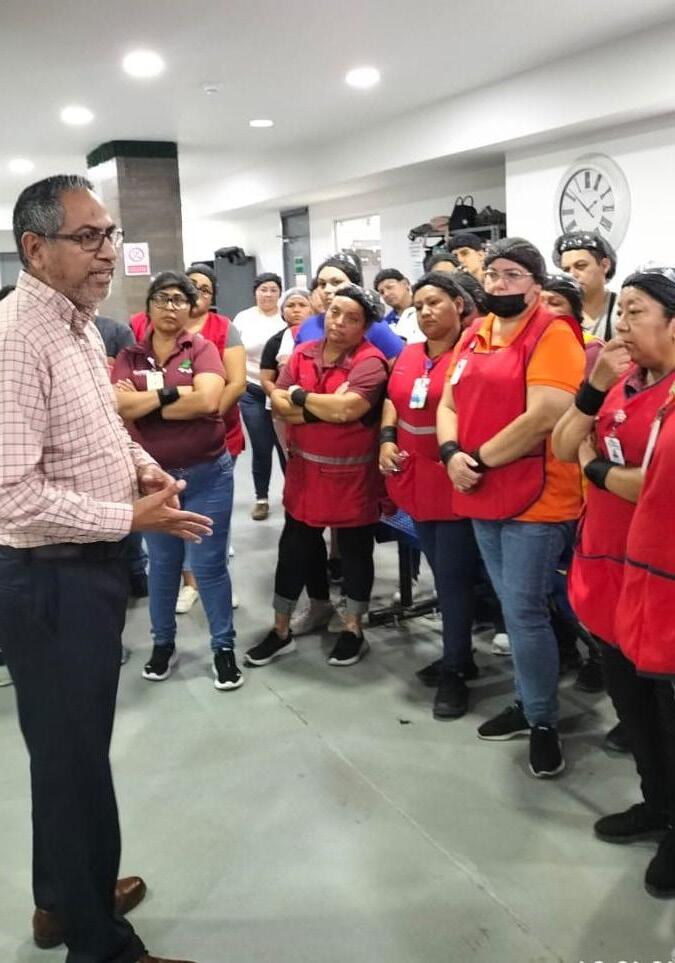
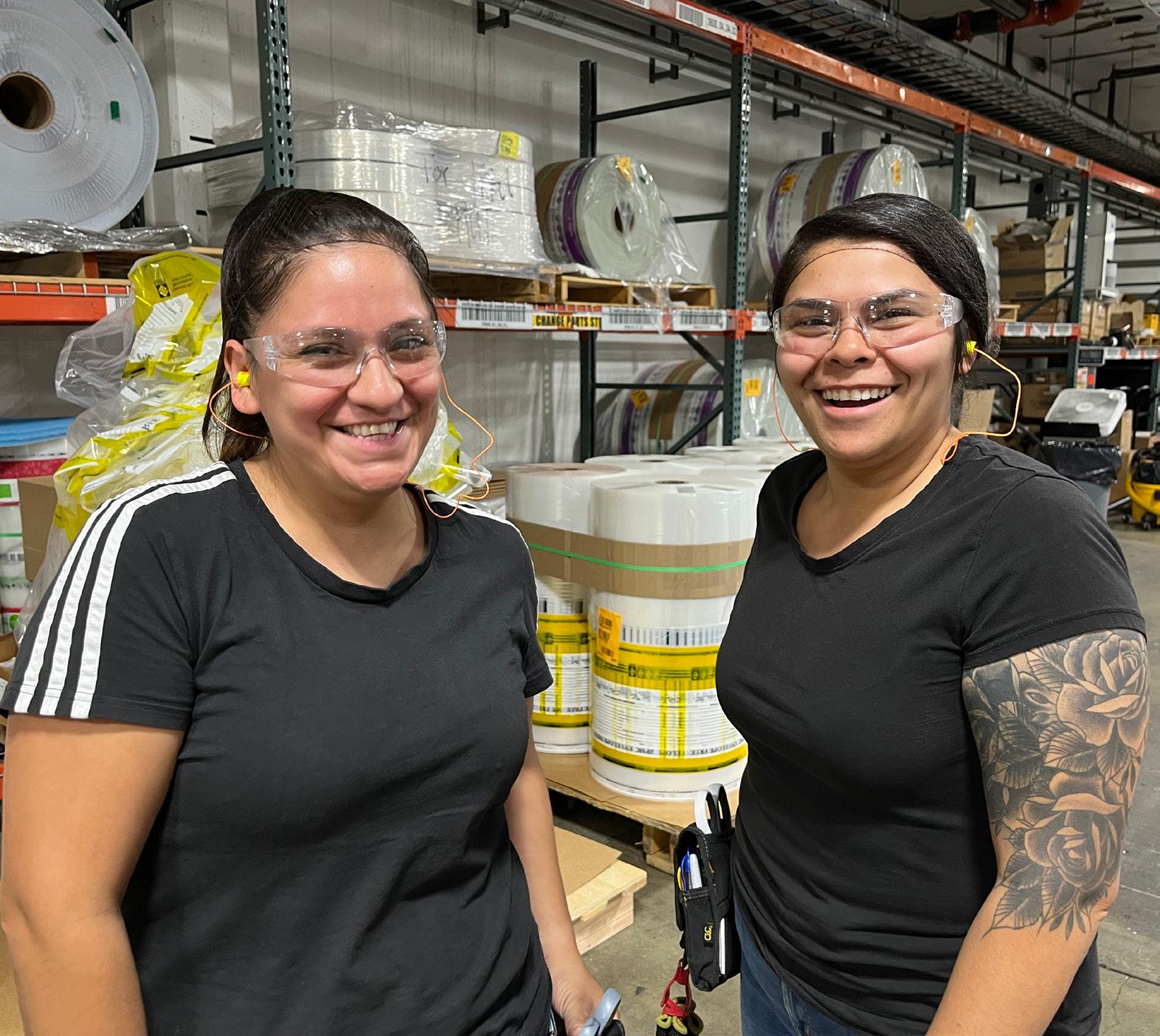

Novolex maintains a zero-tolerance policy concerning the use of illegal, forced, or involuntary labor, human trafficking, child labor or any unfair or discriminatory labor practices. Our Human Rights Policy outlines our commitments and procedures to safeguard human rights, aligning with globally recognized declarations and covenants, including The International Bill of Human Rights and the International Labor Organization’s Declaration on Fundamental Principles and Rights at Work. The Novolex Modern Slavery Statement complements our Human Rights Policy with reference to requirements of the U.K. Modern Slavery Act 2015, the California Transparency in Supply Chains Act, the Dutch Child Labour Due Diligence Law and the Canada Forced Labor and Child Labor in Supply Chains Act[1]. We trained 84 Human Resources and Procurement International Trade Compliance professionals on our Human Rights Policy to promote understanding and compliance. Our policy and efforts to promote understanding across the company reflect the expectations of our customers and others, assuring them of Novolex’s dedication to protecting human rights. We acknowledge that inadequately managed human rights issues could have adverse effects on the workers directly involved and on our employees, contractors, suppliers, customers and others.
Novolex regards all of our suppliers as crucial business partners and requires that they understand and comply with human rights and other ESG practices. The Novolex Supplier Code of Conduct explains our expectations of suppliers covering human rights, labor, environmental and management practices, among other topics. All Novolex suppliers must acknowledge the code upon onboarding via the Coupa supplier management platform. In 2023, more than 99% of all applicable[2] onboarded suppliers agreed to adhere to the code.
1 In 2024, Novolex prepared its report as required by the Act.
2 Excluded organizations include utilities, philanthropies or other non-profits and government entities among others.
Novolex contractual terms also include an obligation for suppliers to adhere to the code. Non-compliance may prompt corrective actions and third-party audits and may lead to contract termination. We grant suppliers and their employees access to the Novolex Ethics and Compliance Hotline to offer a confidential channel to report concerns. As of 2023, 100% of applicable members of the Novolex Procurement organization completed training on the code and all new Procurement organization hires must complete the training as part of their orientation program.
We proactively manage potential risks in our supply chain using the Intertek Inlight™ end-to-end Supplier Qualification Operating System. This system assesses various risk factors to identify suppliers located in high inherent risk countries. Determination of high inherent risk countries is based on country risk scores from the World Bank Governance Indicators, the U.N. Human Development Index, the Transparency International Corruption Index and the U.S. State Department Trafficking in Persons Report. In 2023, 100% of suppliers based in high-risk countries completed the Intertek Self-Assessment Questionnaire, covering human rights and other ESG practices. Suppliers with poor scores must prepare and execute a corrective action plan. Supply chain due diligence is further supported by the Novolex Trade Sanctions Policy, which applies to all imports and exports and covers any interactions associated with countries subject to embargoes or trade sanctions.
In 2023, Novolex formalized its Forced Labor Prevention Program as an additional means to identify risks of the use of forced labor in our supply chain. The program is designed to support compliance with the U.S. Uyghur Forced Labor Prevention Act, which took effect in 2022 and prohibits imports of goods that are suspected to have been mined, produced, or manufactured in China’s Xinjiang Uyghur Autonomous Region. It also supports similar regulations from other jurisdictions in which we or our suppliers operate.
The success of our business relies on the empowerment and well-being of our employees. With a global workforce of more than 10,000 employees, the Novolex family is the foundation of our operations, driving the business forward through their dedication and hard work. Novolex is committed to offering our employees pathways towards career development, making sure that they feel comfortable and supported in an inclusive work environment. The diverse backgrounds and contributions of our employees positions Novolex for long-term success, allowing us to adapt and grow.
We recognize the importance of investing in employee development to foster a winning, entrepreneurial mindset and build rewarding careers. In 2023, we expanded our learning and development team to develop and roll out new programming including on-the-job developmental assignments, e-learning courses and best-in-class, in-person training programs through Novolex University. Annual performance evaluations, talent reviews and continuous one-on-one feedback sessions nurture our talent for increased roles and responsibilities.
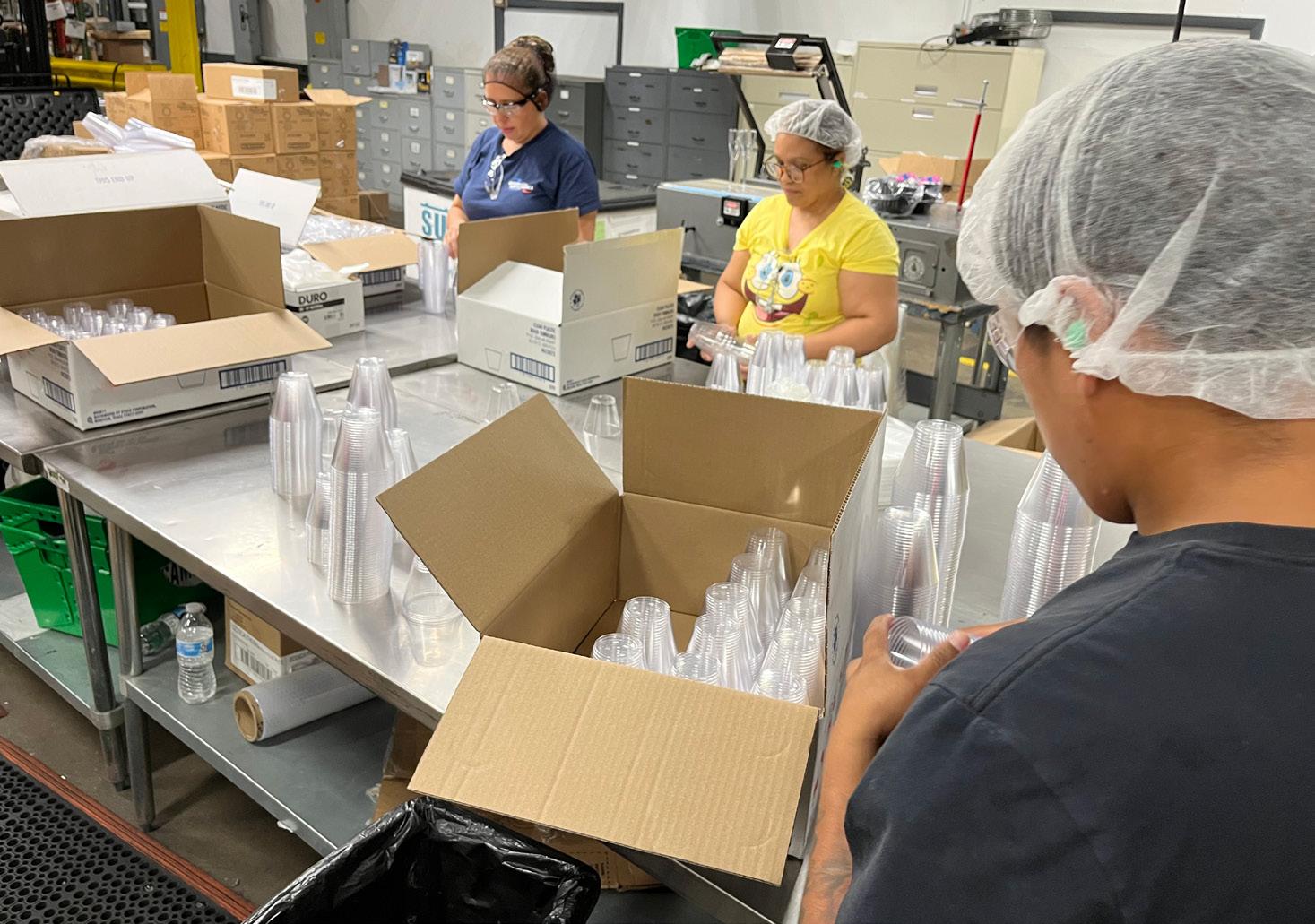

48
In 2023, Novolex conducted 48 sessions of our Supervision Essentials training across 26 locations, reaching over 500 employees. The course focuses on developing first level leaders throughout Novolex.
145,000
In 2023, employees logged more than 145,000 training hours company-wide.
As part of our commitment to employee investment, we encourage all Novolex employees to contribute to and continually learn how to support the company’s sustainability goals. Using various communications platforms, sustainability education at Novolex focuses on product design, composting and recycling labeling, customer goals and targets, carbon emissions-related topics, Product Carbon Footprint analysis and developments related to raw material sustainability. We started sustainability training in 2020, with regular subsequent sessions provided to our sales force, new product development teams and others. The training is delivered by our sustainability team, which refreshes content as expectations and questions around sustainability continue to evolve and as company milestones are achieved. of eligible employees in the U.S. and Canada completed performance reviews in 2023. 98%
Our commitment to develop talent, set out in our Talent Development Program, supports employee growth and advancement.
60% 43%
In 2023, in our U.S. operations we filled 43% of open salaried positions with internal promotions, of which 60% were individuals who identify as women, people of color, or other marginalized identities.
Diversity, Equity and Inclusion (DE&I) embody the core of our company identity which has translated into concrete opportunities. Five pillars comprise the bedrock of our DE&I strategy, which includes annual goal setting and overall business guidance. These pillars are crafted to embed DE&I across all facets of our business and culture. They steer us toward creating a workforce that mirrors the communities in which we operate, providing equitable opportunities for learning and growth in the workplace and fostering a culture where everyone feels included regardless of identity or background.
Reflecting our long-standing commitment to DE&I, in 2023 women or people of color made up 40% of our top 60 leaders and 26% of our plant managers (U.S. and Canada only). The critical positions held by these leaders demonstrate both to colleagues and their communities that Novolex provides opportunities for growth and development for people of diverse backgrounds.
As part of the Leadership Commitment & Accountability pillar of the DE&I strategy, our Novolex DE&I Council is comprised of a diverse cross-section of company leaders who provide governance, guidance and support to ensure that programs and activities align with Novolex DE&I strategies and objectives. DE&I Council members contribute their perspectives to enhance DE&I initiatives, amplifying effective actions across operations and identifying potential barriers. Moreover, Council members share DE&I best practices within their organizational areas and exchange ideas with other Council members, fostering collaboration across Novolex operations. The Novolex Chairman and CEO, Chief Human Resource Officer and Employee Experience Senior Director serve as the DE&I Council sponsors.


In order to ensure that we continue to grow in our DE&I journey, we have established a DE&I Council that drives programming, strategy and goals. The DE&I council is made up of top leaders from across the company. Additionally, leaders across the company will also begin to develop DE&I focused goals for their teams.

In order to attract the best diverse talent to Novolex, we have implemented DE&I best practices in our recruiting processes. This includes training recruiters on how to remove bias from job descriptions as well as training recruiters and hiring managers on how to make less biased hiring decisions. We also examine our processes to better track candidates and work to develop a strong external employer brand to enhance our ability to attract great candidates.

In order to advance efforts that increase the retention and advancement opportunities for the diverse talent within the company, we are deploying training programs to help emphasize the benefits of and opportunities for internal promotion. We also ensure that DE&I best practices are embedded in our Talent Review and Development processes.

In order to foster a culture where our people feel respected, accepted and supported, we work closely with the DE&I Council to develop consistent programming that recognizes cultural identities and their unique contributions to the Novolex community. We also listen to our Novolex family and gather input on additional programs and support systems to help make everyone feel a sense of belonging.

In order to develop and build supplier partnerships that reflect greater diversity, our Procurement team will identify and create opportunities to select diverse suppliers across our value chain. A Procurement team representative is member of the DE&I Council and will work hand in hand with our DE&I leaders to ensure that we optimize use of diverse businesses in our supply chain.

Adrienne Smith doesn’t take shortcuts. She isn’t afraid to jump into hard work, use her voice and prove her point, even if her peers tend to be mostly male. Adrienne oversees 131 employees in our Richmond, Virginia manufacturing center.
I had to prove myself, but that’s what I like to do. Women can do this, we can run these machines, we can do the physical labor, we can do it. I’ve been encouraged by Novolex employees that they have my back. I’m grateful to have had the opportunity to learn from so many skilled people and have them be part of my journey.
“

The DE&I Council collaborates with our DE&I Champions and other crossfunctional, international teams to cultivate an inclusive culture throughout the organization. Our efforts include creating cultural recognition toolkits comprising educational materials, posters and book clubs. In 2023, we held three Inclusion Panels: in June to recognize Pride Month, an overall DE&I program update in August and a session in November focusing on the experiences of veterans at Novolex. These initiatives provide opportunities to educate members of our Novolex family about diverse cultures and perspectives, contributing to the continuous development of our inclusive and welcoming community.
We incorporate DE&I best practices into our recruiting processes to attract top, diverse talent. To promote diverse recruitment, the Talent Acquisition team received training to de-bias job descriptions, with ongoing training planned. Additionally, in 2023, we mandated annual training for all hiring managers to minimize bias during the hiring process, resulting in tangible progress with increased representation of women and people of color across the organization.
Novolex recruiters participate in the National Black MBA Association’s Job Recruitment Fair, connecting with multiple prospective applicants who were previously beyond our reach. We also engage in veterans job fairs, providing opportunities to connect with individuals who served our country, with the aim of hiring them for full-time employment.
The Novolex Supplier Diversity Program implements our commitment to promote diversity in our upstream and downstream supply chains. We identify suppliers who meet diversity criteria for inclusion in our search for new vendors. We also track our quarterly and full year spending with diverse suppliers. Novolex expenditures with diverse suppliers increased 32% over 2022. These metrics are an important tool for measuring the success of our supplier diversity program. Tracking the amount we spend on diverse suppliers also enables us to report expenditures with diverse suppliers to our customers who also value and support diverse businesses in their supply chains.
32%
increase in expenditures with diverse suppliers.

I believe that assembling a team of like-minded engineers alone may not lead to products that cater to everyone. Personally, being visually impaired, I understand the importance of diverse perspectives when designing products, such as food packaging. Our packaging is used by people from various backgrounds, age groups and abilities. By including these diverse voices from the very beginning, we gain invaluable insights on how to craft products that truly resonate with a broader audience.
Stephen Kapantais, Technical Director, Waddington North America
We believe that healthy employees are safer, happier and more productive as reflected in the three philosophies that underpin our benefits programs. Novolex offers a range of benefits and resources to support the well-being of members of the Novolex family. Even in countries with national health programs, Novolex offers benefits to supplement those programs that may not be comprehensive. Every year, Novolex closely monitors, evaluates and may adjust benefits to ensure we provide programs that meet the diverse needs of our employees and their families.

Our benefits program is defined by three fundamental philosophies to help employees and their family members embrace their well-being:
We believe in a holistic approach to well-being. Our benefits are designed to support physical, financial, family and social well-being.
The Novolex Chairman’s Scholarship Program annually awards five children of employees based in the U.S. partial scholarships for four years to post-secondary schools of their choice. An employee panel reviews the students’ applications and selects the winners. Our 2023 scholarship recipients are shown below.



We offer choice. We provide options to ensure our employees can select the plans and programs that they value most and fit their diverse needs.
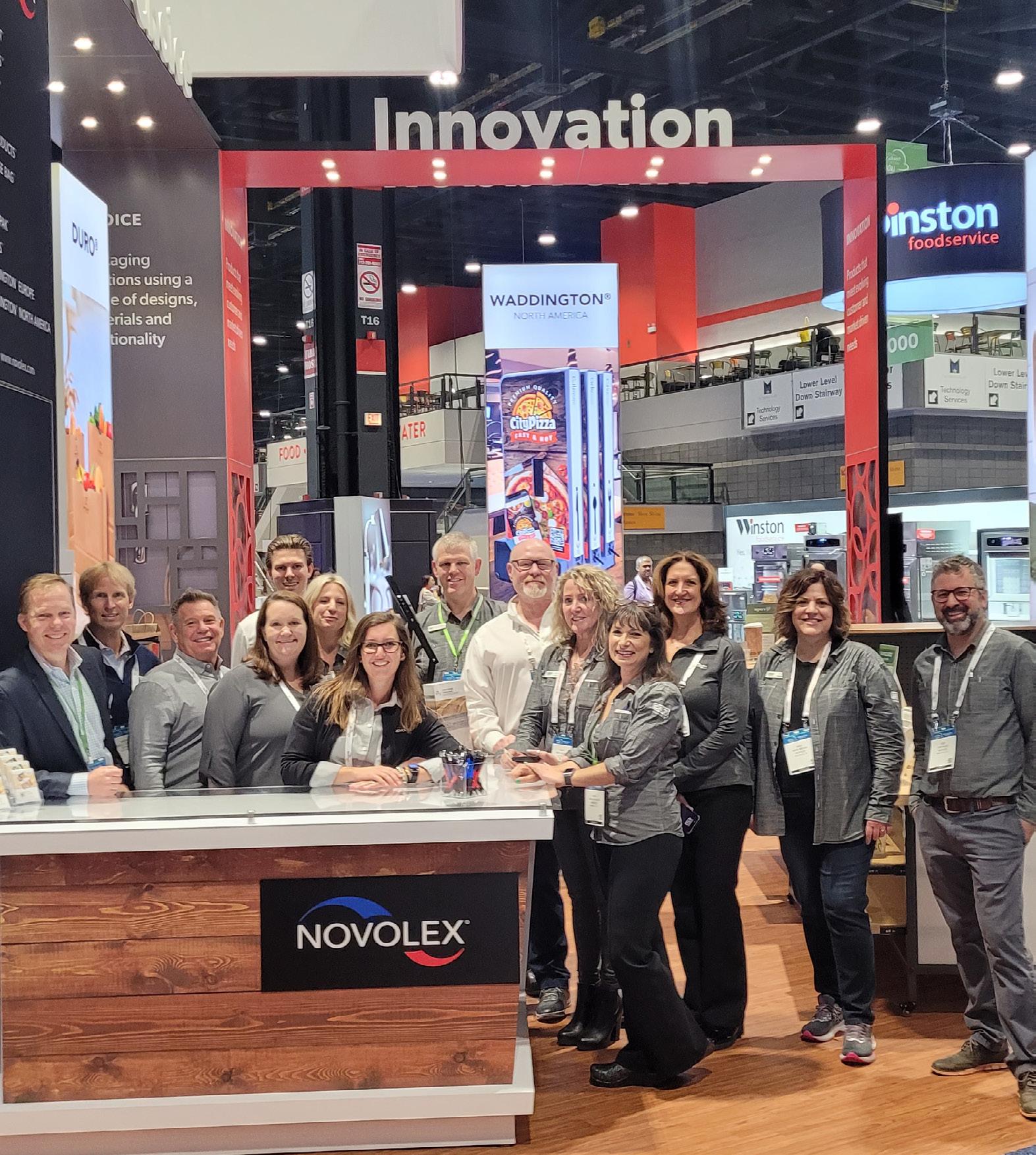


We are family focused. We provide benefits to support our employees and their families, who represent a variety of healthcare needs and life stages.

Our BEAP recognizes employees’ contributions to the growth of the company. The plan enables eligible employees to participate in the success and growth of the company through a potential cash award based on an increased valuation of Novolex over time. The benefit is available to anyone after completing one year of service. Novolex made the first BEAP payout to eligible employees with at least one year of service as of July 24, 2023.
Novolex engages with the communities where we operate, contributing through both donations and volunteer efforts. Our Focused Giving Program channels support organizations aligned with our businesses, products and values, concentrating our efforts with non-profits that address food and hunger needs, sustainability, and health and wellness. We prioritize projects based on employee feedback through our Focused Giving Committee. In addition to supporting diverse community programs, we extend our impact with in-kind donations of Novolex products such as utensils, plates, cups and bags to local non-profit organizations. Donations such as these enable us to address immediate community needs, making a positive impact on lives.
In November, Novolex continued its No Hunger Holidays campaign, donating funds and products to our long-standing partner, Feed the Children. We also invited employees to participate by writing to families receiving boxes from Feed the Children during the holidays for a personalized touch and sharing resources to connect employees with local food banks in their communities.


In 2023, Novolex hosted over 100 giving events across Novolex facility locations and communities.
In honor of Earth Day and Arbor Day, Novolex supported the Arbor Day Foundation’s Community Canopy program through a donation. In appreciation, the Arbor Day Foundation supplied Novolex with 250 trees for employees to plant in their communities. Participating Novolex employees can utilize the Foundation’s online tool to identify the optimal tree-planting locations for maximum energy savings and monitor the tree’s growth. For employees in communities unable to receive trees by mail, Arbor Day will plant a tree on their behalf, eliminating barriers for our employees to engage in this meaningful event.
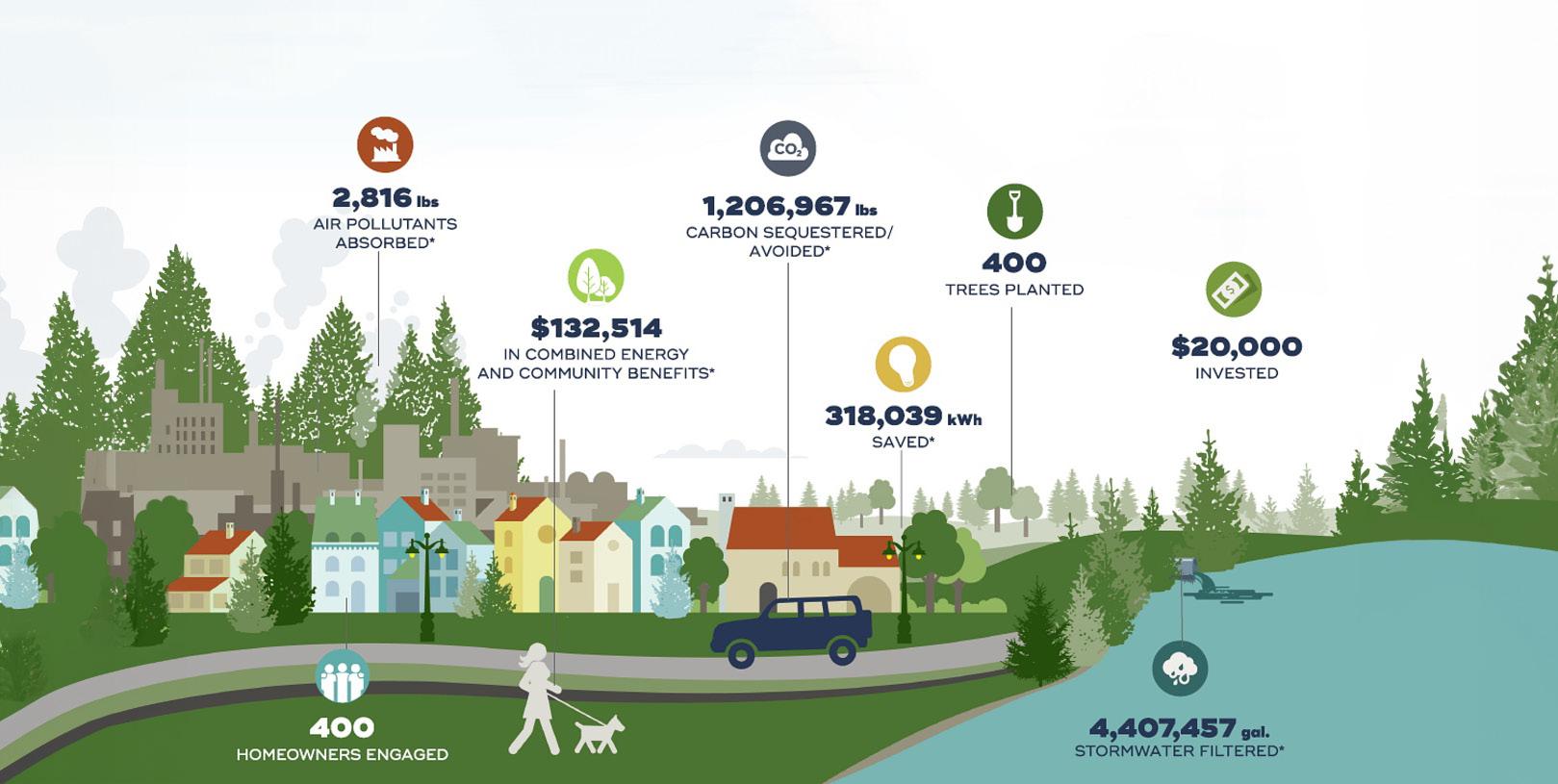
*Projected 20-year cumulative values
In 2020, Novolex engaged a leading sustainability consultancy firm to conduct a materiality assessment. We identified and prioritized topics most important to the business and our stakeholders, resulting in 23 topics, including nine high-priority, Tier 1 topics. Our Tier 1 topics influenced the disclosures addressed in this report, supports the Sustainability Accounting Standards Board’s (SASB) Containers & Packaging industry standard and are reflected in our Global Reporting Initiative (GRI) content index on the following pages. The content index provides Novolex disclosures relevant to the GRI Standards unless otherwise noted. Novolex reports in accordance with the 2021 GRI Universal Standards.

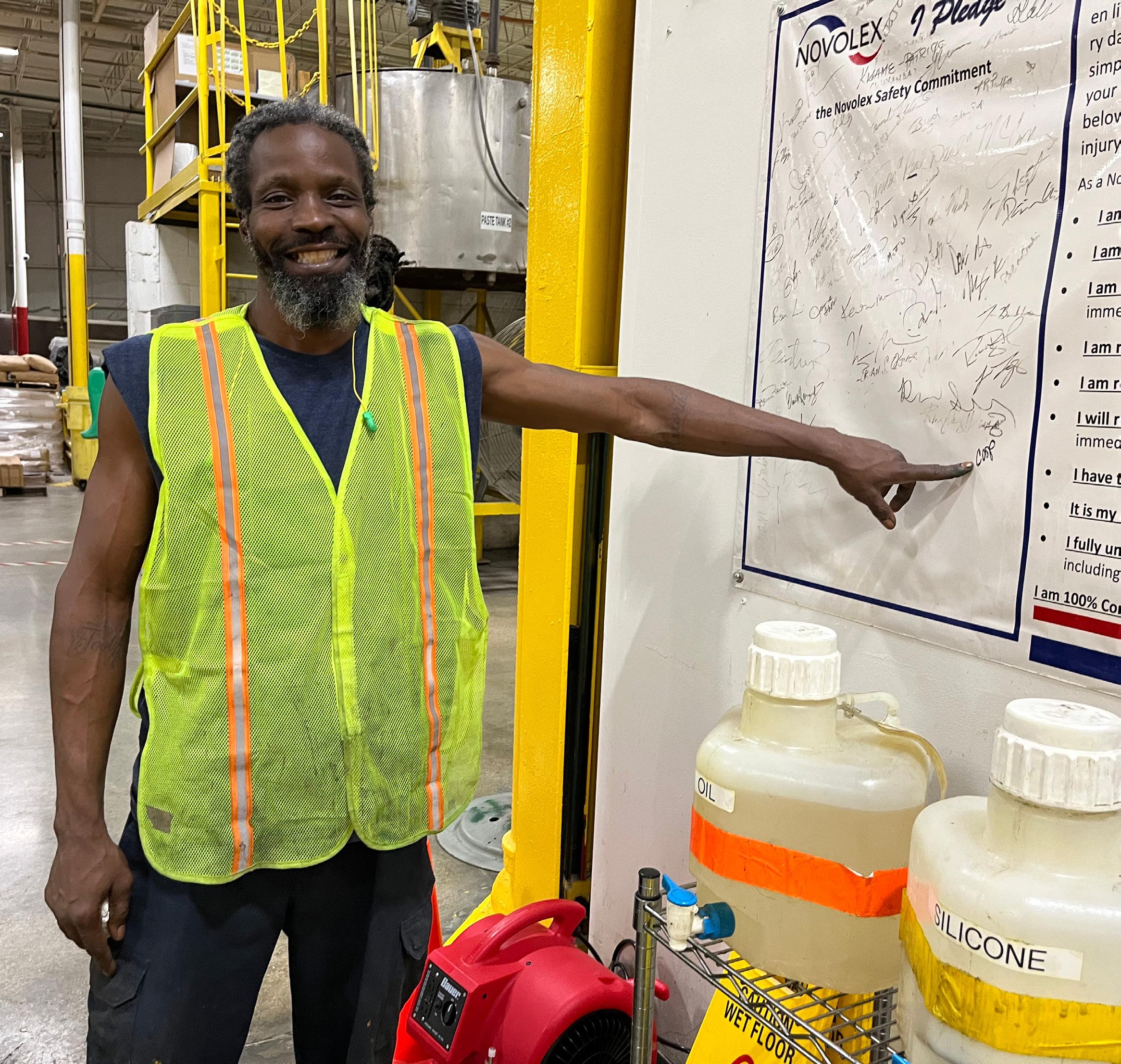
2-1
Organizational details
a. Legal name
b. Nature of ownership and legal form
c. Location of headquarters
d. Countries of operation
2-2 Entities included in the organization’s sustainability reporting
a. Entities included in sustainability reporting.
b. Differences between the entities included in its financial reporting and the entities included in sustainability reporting.
c. If the organization consists of multiple entities, explain the approach used for consolidating information:
i. Whether the approach involves adjustments to information for minority interests;
ii. How the approach takes into account mergers, acquisitions, and disposal of entities or parts of entities;
iii. Whether and how the approach differs across the disclosures in this Standard and across material topics.
a. Sustainability Vision, Pillars & Metrics, pp. 6–7
b. Governance, pp.8–9
c. Charlotte, North Carolina
d. Novolex maintains operations in the U.S., Canada, Mexico, the U.K., Ireland, and the Netherlands.
a. The reporting entity, Novolex Holdings, LLC (“Novolex”), is majority owned and controlled by affiliates of Apollo Global Management through a holding company structure in which the Board Directors of our ultimate parent company is our highest governance body. The reporting covers the activities of Novolex Holdings, LLC and its subsidiaries. See also, Governance, pp.8–9
b., c. (i., ii., iii.)
b. Not applicable
c. Not applicable
b. Novolex is privately held and financial information is not a matter of public record.
c. Novolex Holdings LLC is the consolidating entity.
2-3
Reporting period, frequency, and contact point
a. Reporting period for and frequency of sustainability reporting.
b. Financial reporting period and, if it does not align with the period for sustainability reporting, explaining the reason for this.
c. Publication date of the report or reported information.
d. Contact point for question about the report or reported information.
a. The reporting period is January–December 2023; Novolex publishes a sustainability report annually.
b. The finacial reporting period is January–December 2023; the sustainabiity report is not required to align with the dates of the company’s financial report which is not public.
c. This report was published in July 2024 and covers activities that principally occured in 2023.
d. About Novolex, p. 4
2-4
Restatements of information
2-5
a. Restatements of information made from previous reporting periods:
i. The reasons for the restatements;
ii. The effect of the restatements.
a. Policy and practice for seeking external assurance, including whether and how the highest governance body and senior executives are involved.
b. If the organization’s sustainability reporting has been externally assured:
i. Provide a link or reference to the external assurance report(s) or assurance statement(s);
ii. Describe what has been assured and on what basis, including the assurance standards used, the level of assurance obtained, and any limitations of the assurance process;
iii. Describe the relationship between the organization and the assurance provider.
a. Novolex is restating 2021 emissions due to newly published emissions factors.
a. The company’s sustainability-linked financing requires third-party assurance of annual greenhouse gas (GHG) emissions data which are reviewed by Novolex senior management. The sustainability report is not assured by a third party.
b. i. The Report of Independent Accountants provides assurance of GHG emissions data.
ii. The scope of the assurance covers greenhouse gas (GHG) emissions, total energy consumption, and emissions intensity. The assurance was conducted in accordance with attestation standards established by the American Institute of Certified Public Accountants (AICPA) in AT-C section 105, Concepts Common to All Attestation Engagements, and AT-C section 210, Review Engagements. The assurance relies on information provided by Novolex and considers the principles and guidance of the World Resources Institute (WRI) and the World Business Council for Sustainable Development’s (WBCSD), The Greenhouse Gas Protocol: A Corporate Accounting and Reporting Standard, Revised Edition and the GHG Protocol Scope 2 Guidance: An amendment to the GHG Protocol Corporate Standard (together, the “GHG Protocol”) to guide the criteria to assess, calculate, and report total Scope 1 and 2 emissions, total energy consumption as well as emissions intensity.
iii. We engaged an external third-party to perform an attest review engagement for scope 1 emissions, scope 2 (location and market based) emissions, total energy consumption, and emission intensity disclosed within this Sustainability Report as of December 31, 2023, and for the year then ended.
2-6
Activities, value chain, and other business relationships
2-7
Employees
a. Report the sector(s) in which it is active.
b. Describe the value chain, including:
i. Activities, products, services, and markets served;
ii. The supply chain;
iii. The entities downstream from the organization and their activities.
c. Other relevant business relationships.
d. Significant changes in a, b, and c compared to the previous reporting period.
a. Total number of employees, broken down by gender and region.
b. Total number of:
i. Permanent employees by gender and region;
ii. Temporary employees by gender and region;
iii. Non-guaranteed hours employees by gender and region;
iv. Full-time employees by gender and region; and
v. Part-time employees by gender and region.
c. Methodologies and assumptions used to compile the data, including:
i. Whether the numbers are in head-count, full-time equivalent, or another methodology;
ii. At the end of the reporting period, as an average across the reporting period, or another methodology.
d. Contextual information necessary to understand the data.
e. Significant fluctuations in the number of employees during the reporting period and between reporting periods.
a. Novolex Company Overview Webpage
b. Novolex Company Overview Webpage; Sustainability Vision, Pillars & Metrics, pp. 6–7
c. Policies & Partnerships, How We Engage, p. 19
d. No significant changes in a, b, and c. compared to the previous reporting period.
a. People & Communities, pp.28–38
b. People & Communities, pp.28–38
c. i. The methodology used to compile the data is head-count.
ii. The head-count data reflects permanent employees at the end of the reporting period.
d. Contextual information is not required.
e. There are no significant fluctuations in the number of employees during the reporting period.
2-8
Workers who are not employees
a. Total number of workers who are not employees whose work is controlled by the organization, including:
i. The most common types of worker and their contractual relationship with the organization; and
ii. The type of work they perform.
b. Methodologies and consumptions used to compile the data, including:
i. Whether the numbers are in head-count, full-time equivalent, or another methodology;
ii. At the end of the reporting period, as an average across the reporting period, or another methodology.
c. Significant fluctuations in the number of workers who are not employees during the reporting period and between reporting periods.
a. 837 contractors (temporary workers) were retained during the reporting period.
Retained via local employment agencies: 837
Principally engaged packaging products at company production facilities: 794
b. Numbers are in FTE (40 hrs/wk); some may convert, others are seasonal, and none are on benefits.
c. Numbers may fluctuate due to seasonality.
Governance
2-9
Governance
structure and composition
a. Describe its governance structure, including committees of the highest governance body.
b. List the committees of the highest governance body that are responsible for a. Decision-making on and overseeing the management of the organization’s impacts on the economy, environment, and people.
c. Describe the composition of the highest governance body and its committee:
i. Executive and non-executive members;
ii. Independence;
iii. Tenure of members on the governance body;
iv. Number of other significant positions and commitments held by each member, and the nature of the commitments;
v. Gender;
vi. Under-represented social groups;
vii. Competencies relevant to the impacts of the organization;
viii. Stakeholder representation.
a. The reporting entity, Novolex Holdings, LLC (“Novolex”), is majority owned and controlled by affiliates of Apollo Global Management through a holding company structure in which the Board Directors of our ultimate parent company is our highest governance body. See also, Governance, pp.8–9
b. Governance, pp.8–9
c. Governance, pp.8–9; The Board includes one independent member who is female.
c. vi. Confidentiality constraints
2-10
Nomination and selection of the highest governance body
a. Describe the nomination and selection processes for the highest governance body and its committees.
b. Describe the criteria used for nominating and selecting highest governance body members, including whether and how the following are taken into consideration:
i. Views of stakeholders (including shareholders);
ii. Diversity;
iii. Independence;
iv. Competencies relevant to the impacts of the organization.
2-11
Chair of the highest governance body
2-12
Role of the highest governance body in overseeing the management of impacts
a. Report whether the chair of the highest governance body is also a senior executive.
b. If the chair is also a senior executive, explain their function within the organization’s management, the reasons for this arrangement, and how conflicts of interest are prevented and mitigated.
a. Describe the role of the highest governance body and of senior executives in developing, approving, and updating the organization’s purpose, value or mission statements, strategies, policies, and goals related to sustainable development.
b. Describe the role of the highest governance body in overseeing the organization’s due diligence and other processes to identify and manage the organization’s impacts on the economy, environment, and people, including:
i. Whether and how the highest governance body engages with stakeholders to support these processes;
ii. How the highest governance body considers the outcomes of these processes.
c. Describe the role of the highest governance body in reviewing the effectiveness of the organization’s processes as described in 2-12-b, and report the frequency of this review.
a. The members of the Board were nominated by the principal shareholders. The members of the committees of the Board were selected by the Board.
b. The criteria for nominating and selecting the members of the Board took into consideration:
i. The views of stakeholders (including shareholders);
ii. Diversity;
iii. Independence; and
iv. Competencies relevant to the impacts of the organization.
a. Governance, pp.8–9
b. The Chair of the Board is also the Chief Executive Officer and responsible for oversight of daily operations. He brings to both roles extensive experience in packaging. Any potential conflicts of interest are mitigated through oversight provided by other members of the Board.
a. Governance, pp.8–9
b. Governance, pp.8–9
c. Governance, pp.8–9
2-13
Delegation of Responsibility for managing impacts
a. Describe how the highest governance body delegates responsibility for managing the organization’s impacts on the economy, environment, and people, including:
i. Whether it has appointed any senior executives with responsibility for the management of impacts;
ii. Whether it has delegated responsibility for the management of impacts to other employees.
b. Describe the process and frequency for senior executives or other employees to report back to the highest governance body on the management of the organization’s impacts on the economy, environment, and people.
a. Governance, pp.8–9
b. Governance, pp.8–9
2-14
Role of the highest governance body in sustainability reporting
2-15 Conflicts of interest
a. Report whether the highest governance body is responsible for reviewing and approving the reported information, including the organization’s material topics, and if so, describe the process for reviewing and approving the information.
b. If the highest governance body is not responsible for reviewing and approving the reported information, including the organization’s material topics, explain the reason for this.
a. Describe the processes for the highest governance body to ensure that conflicts of interest are prevented and mitigated.
b. Report whether conflicts of interest are disclosed to stakeholders, including, at a minimum, conflicts of interest relating to:
i. Cross-board membership;
ii. Cross shareholding with suppliers and other stakeholders;
iii. Existence of controlling shareholders;
iv. Related parties, their relationships, transactions, and outstanding balances.
a. The S&EHS Committee of the Board reviews and is given an opportunity to provide feedback to the Senior Leadership Team prior to publication of the report.
b. Not applicable Novolex S&EHS Board Committee reviews our annual sustainability report prior to publication.
a., b (i., ii., iii., iv.) Confidentiality constraints Novolex is privately held and this information is not a matter of public record.
2-16
Communication of critical concerns
2-17
Collective knowledge of the highest governance body
2-18
Evaluation of the performance of the highest governance body
a. Describe whether and how critical concerns are communicated to the highest governance body.
b. Report the total number and the nature of critical concerns that were communicated to the highest governance body during the reporting period.
a. Report measures taken to advance the collective knowledge, skills, and experience of the highest governance body on sustainable development.
a. Critical concerns can be communicated by the Senior Leadership Team during quarterly meetings of the Board or Audit Committee or at other times as needed if matters of concern arise.
Governance, pp.8–9
2-19
Remuneration policies
a. Describe the processes for evaluating the performance of the highest governance body in overseeing the management of the organization’s impacts on the economy, environment, and people.
b. Report whether the evaluations are independent or not, and the frequency of the evaluations.
c. Describe actions taken in response to the evaluations, including changes to the composition of the highest governance body and organizational practices.
a. Describe the remuneration policies for members of the highest governance body and senior executives, including:
i. Fixed pay and variable pay;
ii. Sign-on bonuses or recruitment incentive payments;
iii. Termination payments;
iv. Clawbacks;
v. Retirement benefits.
b. Describe how the remuneration policies for members of the highest governance body and senior executives relate to their objectives and performance in relation to the management of the organization’s impacts on the economy, environment, and people.
b. Selected senior executives are evaluated annually on their performance against goals which include impacts on the economy, environment, and people; Governance, pp.8–9. a. (i., ii., iii., iv., v.) Confidentiality constraints
of public record.
2-20
Process to determine remuneration
2-21
Annual total compensation ratio
a. Describe the process for designing its remuneration policies and for determining remuneration, including:
i. Whether independent highest governance body members or an independent remuneration committee oversees the process for determining remuneration;
ii. How the views of stakeholders (including shareholders) regarding remuneration are sought and taken into consideration;
iii. Whether remuneration consultants are involved in determining remuneration and, if so, whether they are independent of the organization, its highest governance body and senior executives.
b. Report the results of votes of stakeholders (including shareholders) on remuneration policies and proposals, if applicable.
a. Report the ratio of the annual total compensation for the organization’s highest-paid individual to the median annual total compensation for all employees (excluding the highest-paid individual).
b. Report the ratio of the percentage increase in annual total compensation for the organization’s highest-paid individual to the median percentage increase in annual total compensation for all employees (excluding the highest-paid individual).
c. Report contextual information necessary to understand the data and how the data has been compiled.
2-22 Statement on sustainable development strategy
2-23 Policy Commitments
a. Report a statement from the highest governance body or most senior executive of the organization about the relevance of sustainable development to the organization and its strategy for contributing to sustainable development.
a. Describe its policy commitments for responsible business conduct, including:
i. The authoritative intergovernmental instruments that the commitments reference;
ii. Whether the commitments stipulate conducting due diligence;
iii. Whether the commitments stipulate applying the precautionary principle;
iv. Whether the commitments stipulate respecting human rights.
b. Describe its specific policy commitment to respect human rights, including:
i. The internationally recognized human rights that the commitment covers;
ii. The categories of stakeholders, including at-risk or vulnerable groups, that the organization gives particular attention to in the commitment.
c. Provide links to the policy commitments if publicly available, or, if the policy commitments are not publicly available, explain the reason for this.
d. Report the level at which each of the policy commitments was approved within the organization, including whether this is the most senior level.
e. Report the extent to which the policy commitments apply to the organization’s activities and to its business relationships.
f. Describe how the policy commitments are communicated to workers, business partners, and other relevant parties.
a. i. Ethics, Integrity & Human Rights pp. 32–33, Novolex Human Rights Policy, Novolex Statement on Modern Slavery, Novolex Supplier Code of Conduct
ii. Novolex Employee Code of Conduct
iii. Novolex Employee Code of Conduct
iv. Novolex Employee Code of Conduct; Novolex Human Rights Policy
b. i. Ethics, Integrity & Human Rights pp. 32–33; Novolex Human Rights Policy
ii. Novolex Human Rights Policy
c. Novolex Human Rights Policy (website)
d. CEO and Chairman, the senior-most position in the company
e. Ethics, Integrity & Human Rights pp. 32–33; Novolex Employee Code of Conduct, Modern Slavery Statement, and report in compliance with the Canada’s Fighting Against Forced Labour and Child Labour in Supply Chains Act
f. Ethics, Integrity & Human Rights pp. 32–33; Novolex Employee Code of Conduct; Novolex Human Rights Policy; Supplier Code of Conduct; Contractual Terms and Conditions
2-24
Embedding policy commitments
2-25
Processes to remediate negative impacts
a. Describe how it embeds each of its policy commitments for responsible business conduct throughout its activities and business relationships.
i. How it allocates responsibility to implement the commitments across different levels within the organization;
ii. How it integrates the commitments into organizational strategies, operational policies, and operational procedures;
iii. How it implements its commitments with and through its business relationships;
iv. Training that the organization provides on implementing the commitments.
a. Describe its commitments to provide for or cooperate in the remediation of negative impacts that the organization identifies it has caused or contributed to.
b. Describe its approach to identify and address grievances, including the grievance mechanisms that the organization has established or participates in.
c. Describe other processes by which the organization provides for or cooperates in the remediation of negative impacts that it identifies it has caused or contributed to.
d. Describe how the stakeholders who are the intended users of the grievance mechanisms are involved in the design, review, operation, and improvement of these mechanisms.
e. Describe how the organization tracks the effectiveness of the grievance mechanisms and other remediation processes, and report examples of their effectiveness, including stakeholder feedback.
a. i-iv. Novolex Employee Code of Conduct; Ethics, Integrity & Human Rights pp. 32–33
a. Novolex Employee Code of Conduct, Novolex Ethics and Integrity SpeakUp Policy, and Child Labor Remediation Procedure; Novolex Employee Code of Conduct; Ethics, Integrity & Human Rights pp. 32–33
b. Novolex Employee Code of Conduct; Ethics, Integrity & Human Rights pp. 32–33
c. Supplier Code of Conduct; Ethics, Integrity & Human Rights pp. 32–33; Responsible Supply Chains, p. 33
d. Employees are informed of grievance procedures and the Novolex Employee Ethics Hotline during onboarding and on-going via communications and posters to reinforce grievance procedures.
e. Employees can report grievances to their direct supervisors and to their Human Resources representatives. Both Novolex employees and suppliers’ employees have access to the Novolex Ethics and Compliance Hotline to report potential violations of the Novolex Code of Conduct or the Novolex Supplier Code of Conduct, respectively, confidentially and without fear of retaliation.
2-26
Mechanisms for seeking advice and raising concerns
2-27
Compliance with laws and regulations
a. Describe the mechanisms for individuals to:
i. Seek advice on implementing the organization’s policies and practices for responsible business conduct;
ii. Raise concerns about the organization’s business conduct.
a. Report the total number of significant instances of non-compliance with laws and regulations during the reporting period, and a breakdown of this total by:
i. Instances for which fines were incurred;
ii. Instances for which non-monetary sanctions were incurred;
b. Report the total number and the monetary value of fines for instances of noncompliance with laws and regulations that were paid during the reporting period, and a breakdown of this total by:
i. Fines for instances of non-compliance with laws and regulations that occurred in the current reporting period;
ii. Fines for instances of non-compliance with laws and regulations that occurred in previous reporting periods.
c. Describe the significant instances of non-compliance.
d. Describe how it has determined significant instances of non-compliance. a. (i., ii.), b. (i., ii.) c., d.
Confidentiality constraints Novolex does not publicly disclose this information.
The Novolex Employee Code of Conduct stipulates adherence to all local laws and regulations. In instances where OSHA or environmental regulations have not been followed, that information is typically available publicly. We track and work to remedy any areas of non-compliance in our organization.
2-28
Membership associations
a. Report industry associations, other membership associations, and national or international advocacy organizations in which it participates in a significant role.
Stakeholder engagement
2-29
Approach to stakeholder engagement
2-30 Collective bargaining agreements
a. Describe its approach to engaging with stakeholders, including:
i. The categories of stakeholders it engages with, and how they are identified;
ii. The purpose of the stakeholder engagement;
iii. How the organization seeks to ensure meaningful engagement with stakeholders. a. Policies & Partnerships, p. 19
a. Report the percentage of total employees covered by collective bargaining agreements.
b. For employees not covered by collective bargaining agreements, report whether the organization determines their working conditions and terms of employment based on collective bargaining agreements that cover its other employees or based on collective bargaining agreements from other organizations.
a. 23% are hourly union workers; People & Communities, p.28
b. Working conditions in plants without collective agreements are identical to those in facilities with collective agreements.
Material Topics
3-1
Process to determine material topics
3-2
List of material topics
a. Describe the process it has followed to determine its material topics, including:
i. How it has identified actual and potential, negative and positive impacts on the economy, environment, and people, including impacts on their human rights, across its activities and business relationships;
ii. How it has prioritized the impacts for reporting based on their significance.
b. Specify the stakeholders and experts whose views have informed the process of determining its material topics.
a. List its material topics
b. Report changes to the list of material topics compared to the previous reporting period.
a. About Novolex, pp. 4–6; Materiality Assessment, p. 39
b. About Novolex, pp. 4–6; Materiality Assessment, p. 39
a. About Novolex, pp. 4–6; Materiality Assessment, p. 39
b. There are no changes in the material topics identified in our initial assessment.
Management of
a. Describe the actual and potential, negative and positive impacts on the economy, environment, and people, including impacts on their human rights;
b. Report whether the organization is involved with the negative impacts through its activities or as a result of its business relationships, and describe the activities or business relationships;
c. Describe its policies or commitments regarding the material topic;
d. Describe actions taken to manage the topic and related impacts, including:
i. Actions to prevent or mitigate potential negative impacts;
ii. Actions to address actual negative impacts, including actions to provide for or cooperate in their remediation;
iii. Actions to manage actual and potential positive impacts.
e. Report the following information about tracking the effectiveness of the actions taken:
i. Processes used to track the effectiveness of the actions;
ii. Goals, targets, and indicators used to evaluate progress;
iii. The effectiveness of the actions, including progress toward the goals and targets;
iv. Lessons learned and how these have been incorporated into the organization’s operational policies and procedures.
a. Actual and potential, negative and positive impacts on the economy, environment, and people, including impacts on their human rights are covered throughout the report.
b. The manner in which the organization is involved with negative impacts through activities or as a result of business relationships, and the activities or business relationships, are covered throughout the report. Business relationships are covered in Policies & Partnerships, p. 19.
c. About Novolex, pp. 4–6; Sustainability Vision, Pillars & Metrics, pp. 6–7, Products, pp. 10–19; Operations, pp. 20–27
d. About Novolex, pp. 4–6; Products, pp. 10–19; Operations, pp. 20–27
e. About Novolex, pp. 4–6; Products, pp. 10–19; Operations, pp. 20–27
f. About Novolex, pp. 4–6; Products, pp. 10–19; Operations, pp. 20–27
301-1
Materials used by weight or volume
a. Total weight or volume of materials that are used to produce and package the organization’s primary products and services during the reporting period, by:
i. Non-renewable materials used;
ii. Renewable materials used.
301-2
Recycled input materials used
301-3
Reclaimed products and their packaging materials
Products, pp. 10–19
a. Percentage of recycled input materials used to manufacture the organization’s primary products and services. a. Products, pp. 10–19
a. Percentage of reclaimed products and their packaging materials for each product category.
b. How the data for this disclosure have been collected.
b. Information unavailable Reclamation data for specific product types is not widely available.
Management of
1.1
a. Describe the actual and potential, negative and positive impacts on the economy, environment, and people, including impacts on their human rights.
b. Report whether the organization is involved with the negative impacts through its activities or as a result of its business relationships, and describe the activities or business relationships.
c. Describe its policies or commitments regarding the material topic.
d. Describe actions taken to manage the topic and related impacts, including:
i. Actions to prevent or mitigate potential negative impacts;
ii. Actions to address actual negative impacts, including actions to provide for or cooperate in their remediation;
iii. Actions to manage actual and potential positive impacts.
e. Report the following information about tracking the effectiveness of the actions taken:
i. Processes used to track the effectiveness of the actions;
ii. Goals, targets, and indicators used to evaluate progress;
iii. The effectiveness of the actions, including progress toward the goals and targets;
iv. Lessons learned and how these have been incorporated into the organization’s operational policies and procedures.
f. Describe how engagement with stakeholders has informed the actions taken (3-3-d) and how it has informed whether the actions have been effective (3-3-e).
1.2
a. When reporting on GHG emissions targets, the reporting organization shall explain whether offsets were used to meet the targets, including the type, amount, criteria or scheme of which the offsets are part. 1.1
a. Novolex Greenhouse Gas Reduction Target, pp. 21–22; Energy & Emissions, p. 22; Products, pp. 10–19; People & Communities, p. 28
b. We recognize that reliance on virgin fiber and raw materials derived from fossil fuels and other sources have consequences for the environment. Our report acknowledges that these areas require ongoing focus.
c. Novolex Greenhouse Gas Reduction Target, pp. 21–22; Energy & Emissions, p. 22; Products, pp. 10–19; People & Communities, p. 28
d. Novolex Greenhouse Gas Reduction Target, pp. 21–22; Energy & Emissions, p. 22; Products, pp. 10–19; People & Communities, p. 28
e. Novolex Greenhouse Gas Reduction Target, pp. 21–22; Energy & Emissions, p. 22; Products, pp. 10–19; People & Communities, p. 28
f. Greenhouse Gas Reduction Target, pp. 21–22; Products, pp. 10–19; People & Communities, p. 28
1.2
a. Novolex does not use carbon offsets.
305-1
Direct (Scope 1) GHG emissions
a. Gross direct (Scope 1) GHG emissions in metric tons of CO2 equivalent.
b. Gases included in the calculation; whether CO2 , CH4 , N2O, HFCs, PFCs, SF6, NF3, or all.
c. Biogenic CO emissions in metric tons of CO c. 2 2 equivalent.
d. Base year for the calculation, if applicable, including:
i. The rationale for choosing it;
ii. Emissions in the base year;
iii. The context for any significant changes in emissions that triggered recalculations of base year emissions.
e. Source of the emission factors and the global warming potential (GWP) rates used, or a reference to the GWP source.
f. Consolidation approach for emissions; whether equity share, financial control, or operational control.
g. Standards, methodologies, assumptions, and/or calculation tools used.
a. 30,245 (Metric Tons CO2e)
b. CO2, CH4, N2O
c. 0 (Metric Tons CO2e)
d. 2019
i. Greenhouse Gas Reduction Target, pp. 21–22
ii. Greenhouse Gas Reduction Target, pp. 21–22
Base Year Scope 1 Emissions: 30,246 (Metric Tons CO2e)
Base Year Intensity Metric: 0.275 (Scope 1 + Scope 2 Market-Based Metric Tons CO2e Emissions per Metric Ton Production)
iii. Novolex has not had any recalculations of Scope 1 GHG emissions.
e. The Scope 1 emission factors for various countries in 2023 are sourced from several authoritative bodies. For U.S. natural gas, factors are sourced from The Climate Registry (TCR) 2022 Default Emission Factors for the first half of 2023, and from TCR 2023 Default Emission Factors for the second half. Canada’s natural gas factors are from Environment and Climate Change Canada’s 2022 National. The UK’s natural gas uses the 2023 DESNZ Conversion Factors. Mexico’s natural gas factors are from the IPCC Emissions Factor Database (2006), and propane factors are from TCR 2022 Default Emission Factors for the first half of 2023, and TCR 2023 Default Emission Factors for the second half. The Netherlands and Ireland use 2020 UNFCCC CRF Implied Emission Factors from January 1, 2023, to August 31, 2023, and 2021 UNFCCC CRF from September 1, 2023, to December 31, 2023.
f. Operational control
g. Emissions were calculated in alignment with the GHG Protocol: A Corporate Accounting and Reporting Standard.
Minor emission sources (use of diesel generators at a subset of Novolex facilities, mobile uses of propane, motor gasoline and refrigerants) were proven immaterial and excluded from Novolex’s FY23 inventory.
North American natural gas data was provided through a third party, Engie, who compiled a comprehensive report that included natural gas consumption broken down by month. International facilities provided invoices directly to Novolex. In instances where natural gas use for an individual month was missing, estimates were made based on reported data to ensure completeness.
305-2
Energy indirect (Scope 2) GHG emissions
a. Gross location-based energy indirect (Scope 2) GHG emissions in metric tons of CO equivalent.
b. If applicable, gross market-based energy indirect (Scope 2) GHG emissions in metric tons of CO2 equivalent.
c. If available, the gases included in the calculation; whether CO2, CH4 , N2O, HFCs, PFCs, SF6, NF3, or all.
d. Base year for the calculation, if applicable, including:
i. The rationale for choosing it;
ii. Emissions in the base year;
iii. The context for any significant changes in emissions that triggered recalculations of base year emissions.
e. Source of the emission factors and the global warming potential (GWP) rates used, or a reference to the GWP source.
f. Consolidation approach for emissions; whether equity share, financial control, or operational control.
g. Standards, methodologies, assumptions, and/or calculation tools used.
a. 241,025 (Metric Tons CO2e)
b. 230,147 (Metric Tons CO2e)
c. CO2, CH4, and N2O
d. 2019
i. Greenhouse Gas Reduction Target, pp. 21–22
ii. Greenhouse Gas Reduction Target, pp. 21–22
Base Year Scope 2 MB Emissions: 324,611 (Metric Tons CO2e)
Base Year Intensity Metric: 0.275 (Scope 1 + Scope 2 Market-Based Metric Tons CO2e Emissions per Metric Ton Production).
e. Location based methods used the EPA eGRID 2021 (released 2023) for the U.S for the entire year, Environmental and Climate Change Canada National Inventory Report (2022) from January 1, 2023 to April 30, 2023 and Environment and Climate Change National Inventory Report (2023) from May 1, 2023 to December 31, 2023 for Canada, and for all other countries IEA Emission Factor Database 2022 (Year 2020 data) from January 1, 2023 to September 30, 2023 and IEA Emission Factor Database 2023 (Year 2021 data) from October 1, 2023 to December 31, 2023. Market-based methods used the Edison Electric Institute’s Electric Company Carbon Emissions and Electricity Mix Reporting Database for Corporate Customers for the U.S. from January 1, 2023, to June 30, 2023 (EEI, June 2022) and July 1, 2023, to December 31, 2023 (EEI, June 2023), along with the 2022 Nevada Power Company and Sierra Pacific Power Company for the first half of 2023 and the 2022 Green-e® Residual Mix Emissions Rates (2020 Data) for the entire year. For Europe, factors are from the Association of Issuing Bodies (AIB) 2021 RE-DISS Residual Mix Emissions Rates (2022) for the first half of 2023 and the AIB 2022 RE-DISS Residual Mix Rates 2022 (2023) for the second half. Global Warming Potentials were pulled from IPCC’s 2007 fourth assessment (AR4).
f. Operational Control
g. North American natural gas data was provided through a third party, Engie, who compiled a comprehensive report that included natural gas consumption broken down by month. International facilities provided invoices directly to Novolex. In instances where natural gas use for an individual month was missing, estimates were made based on reported data to ensure completeness. International facilities provided invoices directly to Novolex. In instances where electricity use for an individual month was missing, estimates were made based on reported data to ensure completeness.
305-3
Other indirect (Scope 3) GHG emissions
305-4
a. Gross other indirect (Scope 3) GHG emissions in metric tons of CO2 equivalent.
b. If available, the gases included in the calculation; whether CO2, CH4, N2O, HFCs, PFCs, SF6 , NF3 , or all.
c. Biogenic CO2 emissions in metric tons of CO2 equivalent.
d. Other indirect (Scope 3) GHG emissions categories and activities included in the calculation.
e. Base year for the calculation, if applicable, including:
i. The rationale for choosing it;
ii. Emissions in the base year;
iii. The context for any significant changes in emissions that triggered recalculations of base year emissions.
f. Source of the emission factors and the global warming potential (GWP) rates used, or a reference to the GWP source.
g. Standards, methodologies, assumptions, and/or calculation tools used. a., b.,
a. GHG emissions intensity ratio for the organization.
b. Organization-specific metric (the denominator) chosen to calculate the ratio.
c. Types of GHG emissions included in the intensity ratio; whether direct (Scope 1), energy indirect (Scope 2), and/or other indirect (Scope 3).
d. Gases included in the calculation; whether CO2, CH4, N2O, HFCs, PFCs, SF6, NF3, or all.
a. 0.209 (Scope 1 + Scope 2 Market-Based Metric Tons CO2e Emissions per Metric Ton Production)
b. Metric Tons Production
c. Scope 1 and Scope 2 Market-Based Emissions
d. CO2, CH4, and N2O
Energy & Emissions, p. 22
Data is currently unavailable, but Novolex is developing Scope 3 calculation processes for the next reporting year.
305-5
Reduction of GHG emissions
305-6
Emissions of ozone-depleting substances (ODS)
a. GHG emissions reduced as a direct result of reduction initiatives, in metric tons of CO2 equivalent.
b. Gases included in the calculation; whether CO2 , CH4 , N2O, HFCs, PFCs, SF6 , NF3 , or all.
c. Base year or baseline, including the rationale for choosing it.
d. Scopes in which reductions took place; whether direct (Scope 1), energy indirect (Scope 2), and/or other indirect (Scope 3).
e. Standards, methodologies, assumptions, and/or calculation tools used.
a. Production, imports, and exports of ODS in metric tons of CFC-11 (trichlorofluoromethane) equivalent.
b. Substances included in the calculation.
c. Source of the emission factors used.
d. Standards, methodologies, assumptions, and/or calculation tools used.
305-7 Nitrogen oxides (NOX), sulfur oxides (SOX), and other significant air emissions
a. Significant air emissions, in kilograms or multiples, for each of the following:
i. Nitrogen oxides (NOX);
ii. Sulfur oxides (SOX);
iii. Persistent organic pollutants (POP);
iv. Volatile organic compounds (VOC);
v. Hazardous air pollutants (HAP);
vi. Particulate matter (PM);
vii. Other standard categories of air emissions identified in relevant regulations.
b. Source of the emission factors used.
c. Standards, methodologies, assumptions, and/or calculation tools used.
a. Operations, pp. 21–28
b. CO2, CH4, N2O
c. Operations, pp. 21–28
d. Operations, pp. 21–28
e. Our data is assured by a third party: Report of Independent Accountant: https://novolex.com/content/PDF/Novolex-2023-Limited-AssuranceReport.pdf
a., b., c., d. Information Unavailable Novolex does not report this information.
a. i. Air Emissions, p. 23
ii. Air Emissions, p. 23
iv. Air Emissions, p. 23
vi. Air Emissions, p. 23
b. Novolex uses the EPA emission factor AP-42: Compilation of Air Pollutant Factors.
c. Novolex takes its actual natural gas consumption and applies the EPA emission factor AP-42 to calculate its air emissions by facility.
a. (iii., v., vii.) Information Unavailable Novolex does not report this information.
3-3
Management of material topics
306-1 Waste generation and significant waste-related impacts
a. Describe the actual and potential, negative and positive impacts on the economy, environment, and people, including impacts on their human rights.
b. Report whether the organization is involved with the negative impacts through its activities or as a result of its business relationships, and describe the activities or business relationships.
c. Describe its policies or commitments regarding the material topic.
d. Describe actions taken to manage the topic and related impacts, including:
i. Actions to prevent or mitigate potential negative impacts;
ii. Actions to address actual negative impacts, including actions to provide for or cooperate in their remediation;
iii. Actions to manage actual and potential positive impacts.
e. Report the following information about tracking the effectiveness of the actions taken:
i. Processes used to track the effectiveness of the actions;
ii. Goals, targets, and indicators used to evaluate progress;
iii. The effectiveness of the actions, including progress toward the goals and targets;
iv. Lessons learned and how these have been incorporated into the organization’s operational policies and procedures.
f. Describe how engagement with stakeholders has informed the actions taken (3-3-d) and how it has informed whether the actions have been effective (3-3-e).
a. For the organization’s significant actual and potential waste-related impacts, a description of:
i. The inputs, activities, and outputs that lead or could lead to these impacts;
ii. Whether these impacts relate to waste generated in the organization’s own activities or to waste generated upstream or downstream in its value chain.
a. Products, pp. 10–19; Air, Waste & Water, pp. 23–26
b. Products, pp. 10–19; Air, Waste & Water, pp. 23–26
c. Products, pp. 10–19; Air, Waste & Water, pp. 23–26
d. Products, pp. 10–19; Air, Waste & Water, pp. 23–26
ii. Negative impacts can occur along the company’s supply chain. For example, GHG emissions result from waste. While we are still working to quantify the emissions from waste, Novolex is taking steps to measure and manage our waste diverted to landfills.
e. Products, pp. 10–19; Air, Waste & Water, pp. 23–26
f. Products, pp. 10–19; Air, Waste & Water, pp. 23–26
a. Products, pp. 10–19; Air, Waste & Water, pp. 23–26
306-2
Management of significant wasterelated impacts
a. Actions, including circularity measures, taken to prevent waste generation in the organization’s own activities and upstream and downstream in its value chain, and to manage significant impacts from waste generated.
b. If the waste generated by the organization in its own activities is managed by a third party, a description of the processes used to determine whether the third party manages the waste in line with contractual or legislative obligations.
c. The processes used to collect and monitor waste-related data.
306-3 Waste generated
a. Total weight of waste generated in metric tons, and a breakdown of this total by composition of the waste.
b. Contextual information necessary to understand the data and how the data has been compiled.
306-4
Waste diverted to disposal
a. Total weight of waste diverted from disposal in metric tons, and a breakdown of this total by composition of the waste.
b. Total weight of hazardous waste diverted from disposal in metric tons, and a breakdown of this total by the following recovery operations:
i. Preparation for reuse;
ii. Recycling;
iii. Other recovery operations.
c. Total weight of non-hazardous waste diverted from disposal in metric tons, and a breakdown of this total by the following recovery operations:
i. Preparation for reuse;
ii. Recycling;
iii. Other recovery operations.
d. For each recovery operation listed in Disclosures 306-4-b and 306-4-c, a breakdown of the total weight in metric tons of hazardous waste and of non-hazardous waste diverted from disposal:
i. Onsite;
ii. Offsite.
e. Contextual information necessary to understand the data and how the data has been compiled.
a. Products, pp. 10–19; Air, Waste & Water, pp. 23–26
b. Products, pp. 10–19; Air, Waste & Water, pp. 23–26
c. Products, pp. 10–19; Air, Waste & Water, pp. 23–26
a. Products, pp. 10–19; Air, Waste & Water, pp. 23–26
b. Products, pp. 10–19; Air, Waste & Water, pp. 23–26
a. Products, pp. 10–19; Air, Waste & Water, pp. 23–26
Total waste generated:74,858.33 MT
Non-hazardous waste: 74,760.36 MT
Hazardous waste: 97.97 MT
c. Total non-hazardous waste diverted: 56,327.07 MT
ii. Recycled: 56,307.47 MT
iii. Composted: 19.64 MT
Digested: 0 MT
e. Novolex used a excel based data collection method, working with waste-hauler partners to identify pounds of waste generated onsite broken down by facility, type (i.e., plastic, paper, etc.) and treatment (i.e., recycled, landfilled, etc.). A master facility list provided by Novolex was used as a reference to track which facilities we had received data for. At the end of the process, estimations were made for landfilled waste for US and Mexico facilities that did not already report this quantity. The estimations were based on the square footage and reported landfilled waste of the US facilities that did report their landfilled waste.
b. Partial gap Information Unavailable Novolex does not currently report the breakdown of this information for hazardous waste.
b. (i., ii., iii.), c. i., d. (i., ii.) Information Unavailable Novolex does not report this information.
306-5
Waste directed to disposal
a. Total weight of waste directed to disposal in metric tons, and a breakdown of this total by composition of the waste.
b. Total weight of hazardous waste directed to disposal in metric tons, and a breakdown of this total by the following disposal operations:
i. Incineration (with energy recovery);
ii. Incineration (without energy recovery);
iii. Landfilling;
iv. Other disposal operations.
c. Total weight of non-hazardous waste directed to disposal in metric tons, and a breakdown of this total by the following disposal operations:
i. Incineration (with energy recovery);
ii. Incineration (without energy recovery);
iii. Landfilling;
iv. Other disposal operations.
d. For each disposal operation listed in Disclosures 306-5-b and 306-5-c, a breakdown of the total weight in metric tons of hazardous waste and of non-hazardous waste directed to disposal:
i. Onsite;
ii. Offsite.
e. Contextual information necessary to understand the data and how the data has been compiled.
c. Total non-hazardous waste directed to disposal: 18,433.29 MT iii. 17,603.00 MT
iv. Incineration(energy recovery unknown): 830.30
Information unavailable Novolex does not report this information.
3-3
Management of
a. Describe the actual and potential, negative and positive impacts on the economy, environment, and people, including impacts on their human rights;
b. Report whether the organization is involved with the negative impacts through its activities or as a result of its business relationships, and describe the activities or business relationships;
c. Describe its policies or commitments regarding the material topic;
d. Describe actions taken to manage the topic and related impacts, including:
i. Actions to prevent or mitigate potential negative impacts;
ii. Actions to address actual negative impacts, including actions to provide for or cooperate in their remediation;
iii. Actions to manage actual and potential positive impacts.
e. Report the following information about tracking the effectiveness of the actions taken:
i. Processes used to track the effectiveness of the actions;
ii. Goals, targets, and indicators used to evaluate progress;
iii. The effectiveness of the actions, including progress toward the goals and targets;
iv. Lessons learned and how these have been incorporated into the organization’s operational policies and procedures.
f. Describe how engagement with stakeholders has informed the actions taken (3-3-d) and how it has informed whether the actions have been effective (3-3-e).
403-1
Occupational health and safety management system
a. A statement of whether an occupational health and safety management system has been implemented, including whether:
i. The system has been implemented because of legal requirements and, if so, a list of the requirements;
ii. The system has been implemented based on recognized risk management and/or management system standards/guidelines and, if so, a list of the standards/guidelines.
b. A description of the scope of workers, activities, and workplaces covered by the occupational health and safety management system, and an explanation of whether and, if so, why any workers, activities, or workplaces are not covered.
a. Safety, pp. 31–32; the Novolex Health and Safety Management System is fit for purpose and aligned with industry best practices that can exceed legal and regulatory requirements or recognized industry standards or guidelines. The latter include regulations promulgated by the US Occupational Safety and Health Administration and industry standards published by the National Institute of Occupational Health and Safety, the American National Standards Institute, the US National Fire Protection Association and analogous regulations and standards in other countries in which we operate.
b. All locations and workers (salaried, hourly, and temporary employees), and required safety activity/requirement are covered in the Novolex Health and Safety programs with the exception of some activities that must be conducted by 3rd parties (i.e., Audiometric testing, Industrial Hygiene Assessments).
403-2 Hazard identification, risk assessment, and incident investigation
a. A description of the processes used to identify work-related hazards and assess risks on a routine and non-routine basis, and to apply the hierarchy of controls in order to eliminate hazards and minimize risks, including:
i. How the organization ensures the quality of these processes, including the competency of persons who carry them out;
ii. How the results of these processes are used to evaluate and continually improve the occupational health and safety management system.
b. A description of the processes for workers to report work-related hazards and hazardous situations, and an explanation of how workers are protected against reprisals.
c. A description of the policies and processes for workers to remove themselves from work situations that they believe could cause injury or ill health, and an explanation of how workers are protected against reprisals.
d. A description of the processes used to investigate work-related incidents, including the processes to identify hazards and assess risks relating to the incidents, to determine corrective actions using the hierarchy of controls, and to determine improvements needed in the occupational health and safety management system.
a. i. Plants are supported by ten dedicated corporate Health & Safety positions that are complemented by plant leadership, facility health and safety leaders, and production supervisors who assist, support, and review the identification and abatement of workplace hazards. Additionally, as needed we engage 3rd party consultants to conduct safety assessments including but not limited to companies being considered for acquisition.
ii. Safety, pp. 31–32
b. Safety, pp. 31–32
c. Safety, pp. 31–32
d. Safety, pp. 31–32
403-3
Occupational health services
a. A description of the occupational health services’ functions that contribute to the identification and elimination of hazards and minimization of risks, and an explanation of how the organization ensures the quality of these services and facilitates workers’ access to them.
Recommended Disclosures:
1.3.1. How the organization maintains the confidentiality of workers’ personal health-related information;
1.3.2. How the organization ensures that workers’ personal health-related information and their participation in any occupational health services is not used for any favorable or unfavorable treatment of workers.
a. Safety, pp. 31–32; In addition, audiometric testing is conducted annually as required in locations covered by our Hearing Conservation Program which includes the use of hearing protection PPE. Testing is conducted by a third party to ensure compliance. Noise surveys are also conducted in the course of assessing a facility for acquisition. Other industrial hygiene testing is conducted when needed.
Recommended Disclosures:
1.3.1. Medical records are kept confidential through the inclusion of Human Resources in all Workers Compensation Claims Management. Names or other identifying information, including medical records, are not shared in communications regarding incidents with the exception of disclosures in compliance with HIPAA regulations;
1.3.2. Health-related information is not used to influence treatment of workers and would only be used in the event that an employee would not be able to safely conduct a job or task based on fitness for duty and/or safety concerns, in which case employees would be involved in a confidential ADAA assessment.
403-4
Worker participation, consultation, and communication on occupational health and safety
403-5
Worker training on occupational health and safety
a. A description of the processes for worker participation and consultation in the development, implementation, and evaluation of the occupational health and safety management system, and for providing access to and communicating relevant information on occupational health and safety to workers.
b. Where formal joint management-worker health and safety committees exist, a description of their responsibilities, meeting frequency, decision-making authority, and whether and, if so, why any workers are not represented by these committees.
a. A description of any occupational health and safety training provided to workers, including generic training as well as training on specific work-related hazards, hazardous activities, or hazardous situations.
a. Safety, pp. 31–32
b. Safety, pp. 31–32; Union agreements at all sites include provisions in collective bargaining agreements pertaining to safety. Regardless of union status, all Novolex sites treat safety matters in the same manner. Safety topics are included in all company handbooks and collective bargaining agreements.
a. Safety, pp. 31–32; Ethics, Integrity & Human Rights pp. 32–33; Novolex Supplier Code of Conduct
403-6
Promotion of worker health
403-7
Prevention and mitigation of occupational health and safety impacts directly linked by business relationships
403-8
Workers covered by an occupational health and safety management system
a. An explanation of how the organization facilitates workers’ access to nonoccupational medical and healthcare services, and the scope of access provided.
b. A description of any voluntary health promotion services and programs offered to workers to address major non-work-related health risks, including the specific health risks addressed, and how the organization facilitates workers’ access to these services and programs.
a. A description of the organization’s approach to preventing or mitigating significant negative occupational health and safety impacts that are directly linked to its operations, products, or services by its business relationships, and the related hazards and risks.
a. Employee Health & Well-Being, p. 37
b. Employee Health & Well-Being, p. 37
Safety, pp. 31–32
a. If the organization has implemented an occupational health and safety management system based on legal requirements and/or recognized standards/guidelines:
i. The number and percentage of all employees and workers who are not employees but whose work and/or workplace is controlled by the organization, who are covered by such a system;
ii. The number and percentage of all employees and workers who are not employees but whose work and/or workplace is controlled by the organization, who are covered by such a system that has been internally audited;
iii. The number and percentage of all employees and workers who are not employees but whose work and/or workplace is controlled by the organization, who are covered by such a system that has been audited or certified by an external party.
b. Whether and, if so, why any workers have been excluded from this disclosure, including the types of worker excluded.
c. Any contextual information necessary to understand how the data have been compiled, such as any standards, methodologies, and assumptions used.
a. Safety, pp. 31–32; the Novolex Health and Safety Management System is fit for purpose and aligned with industry best practices that can exceed regulatory requirements or recognized industry standards or guidelines.
i. The management system covers 100% of employees and workers; People & Communities pp. 28–38; In addition to employees, 600 workers who were not Novolex employees were temporarily employed during the reporting year.
ii. All employees and workers are covered by an internally audited Management system; the number of contractors covered under this Management system is not available.
b. No workers are excluded from the management system.
a. iii., c. a iii. Information unavailable
c. Not applicable Novolex does not track this information at this level. No contextual information is required.
403-9
Work-related injuries
a. For all employees:
i. The number and rate of fatalities as a result of work-related injury;
ii. The number and rate of high-consequence work-related injuries (excluding fatalities);
iii. The number and rate of recordable work-related injuries;
iv. The main types of work-related injury;
v. The number of hours worked.
b. For all workers who are not employees but whose work and/or workplace is controlled by the organization:
i. The number and rate of fatalities as a result of work-related injury;
ii. The number and rate of high-consequence work-related injuries (excluding fatalities);
iii. The number and rate of recordable work-related injuries;
iv. The main types of work-related injury;
v. The number of hours worked.
c. The work-related hazards that pose a risk of high-consequence injury, including:
i. how these hazards have been determined;
ii. which of these hazards have caused or contributed to high-consequence injuries during the reporting period;
iii. actions taken or underway to eliminate these hazards and minimize risks using the hierarchy of controls.
d. Any actions taken or underway to eliminate other work-related hazards and minimize risks using the hierarchy of controls.
e. Whether the rates have been calculated based on 200,000 or 1,000,000 hours worked.
f. All employees under Novolex supervision are captured in our work-related injury metrics.
g. Any contextual information necessary to understand how the data have been compiled, such as any standards, methodologies, and assumptions used.
d. Safety, pp. 31–32
e. 200,000 hours worked
f. All employees under Novolex supervision are captured in our work-related injury metrics. a. (i., ii., iii., iv., v.), b. (i., ii., iii., iv., v.), c. (i., ii., iii.), g.
Confidentiality constraints Novolex does not publicly report this information.
403-10
Work-related ill health
a. For all employees:
i. The number of fatalities as a result of work-related ill health;
ii. The number of cases of recordable work-related ill health;
iii. The main types of work-related ill health.
b. For all workers who are not employees but whose work and/or workplace is controlled by the organization:
i. The number of fatalities as a result of work-related ill health;
ii. The number of cases of recordable work-related ill health;
iii. The main types of work-related ill health.
c. The work-related hazards that pose a risk of ill health, including:
i. how these hazards have been determined;
ii. which of these hazards have caused or contributed to cases of ill health during the reporting period;
iii. actions taken or underway to eliminate these hazards and minimize risks using the hierarchy of controls;
iv. Whether and, if so, why any workers have been excluded from this disclosure, including the types of worker excluded.
d. Any contextual information necessary to understand how the data have been compiled, such as any standards, methodologies, and assumptions used.
3-3 Management
a. Describe the actual and potential, negative and positive impacts on the economy, environment, and people, including impacts on their human rights.
b. Report whether the organization is involved with the negative impacts through its activities or as a result of its business relationships, and describe the activities or business relationships.
c. Describe its policies or commitments regarding the material topic.
d. Describe actions taken to manage the topic and related impacts, including:
i. Actions to prevent or mitigate potential negative impacts;
ii. Actions to address actual negative impacts, including actions to provide for or cooperate in their remediation;
iii. Actions to manage actual and potential positive impacts.
e. Report the following information about tracking the effectiveness of the actions taken:
i. Processes used to track the effectiveness of the actions;
ii. Goals, targets, and indicators used to evaluate progress;
iii. The effectiveness of the actions, including progress toward the goals and targets;
iv. Lessons learned and how these have been incorporated into the organization’s operational policies and procedures.
f. Describe how engagement with stakeholders has informed the actions taken (3-3-d) and how it has informed whether the actions have been effective (3-3-e).
a. Diversity, Equity & Inclusion, pp. 35–36
b. Diversity, Equity & Inclusion, pp. 35–36
c. Diversity, Equity & Inclusion, pp. 35–36
d. Diversity, Equity & Inclusion, pp. 35–36
e. Diversity, Equity & Inclusion, pp. 35–36
f. Diversity, Equity & Inclusion, pp. 35–36
405-1
Diversity of governance bodies and employees
405-2
Ratio of basic salary and remuneration of women to men
a. Percentage of individuals within the organization’s governance bodies in each of the following diversity categories:
i. Gender;
ii. Age group: under 30 years old, 30–50 years old, over 50 years old;
iii. Other indicators of diversity where relevant (such as minority or vulnerable groups).
b. Percentage of employees per employee category in each of the following diversity categories:
i. Gender;
ii. Age group: under 30 years old, 30–50 years old, over 50 years old;
iii. Other indicators of diversity where relevant (such as minority or vulnerable groups).
a. Ratio of the basic salary and remuneration of women to men for each employee category, by significant locations of operation.
b. The definition used for ‘significant locations of operation.
a. i. Board by Gender: 78% Male, 22% Female; Senior Leadership Team by Gender: 78% Male, 22% Female
ii. People & Communities pp. 28–38
iii. Board by Race & Ethnicity: 100% White, Senior Leadership Team by Race & Ethnicity: 89% White, 11% People of Color
b. People & Communities, p. 29
a., b. Information unavailable Novolex does not report this information.
a. Describe the actual and potential, negative and positive impacts on the economy, environment, and people, including impacts on their human rights.
b. Report whether the organization is involved with the negative impacts through its activities or as a result of its business relationships, and describe the activities or business relationships.
c. Describe its policies or commitments regarding the material topic.
d. Describe actions taken to manage the topic and related impacts, including:
i. Actions to prevent or mitigate potential negative impacts;
ii. Actions to address actual negative impacts, including actions to provide for or cooperate in their remediation;
iii. Actions to manage actual and potential positive impacts.
e. Report the following information about tracking the effectiveness of the actions taken:
i. Processes used to track the effectiveness of the actions;
ii. Goals, targets, and indicators used to evaluate progress;
iii. The effectiveness of the actions, including progress toward the goals and targets;
iv. Lessons learned and how these have been incorporated into the organization’s operational policies and procedures.
f. Describe how engagement with stakeholders has informed the actions taken (3-3-d) and how it has informed whether the actions have been effective (3-3-e).
a. Total monetary value of financial and in-kind political contributions made directly and indirectly by the organization by country and recipient/beneficiary.
b. If applicable, how the monetary value of in-kind contributions was estimated.
3-3 Management of material topics
a. Describe the actual and potential, negative and positive impacts on the economy, environment, and people, including impacts on their human rights.
b. Report whether the organization is involved with the negative impacts through its activities or as a result of its business relationships, and describe the activities or business relationships.
c. Describe its policies or commitments regarding the material topic.
d. Describe actions taken to manage the topic and related impacts, including:
i. Actions to prevent or mitigate potential negative impacts;
ii. Actions to address actual negative impacts, including actions to provide for or cooperate in their remediation;
iii. Actions to manage actual and potential positive impacts.
e. Report the following information about tracking the effectiveness of the actions taken:
i. Processes used to track the effectiveness of the actions;
ii. Goals, targets, and indicators used to evaluate progress;
iii. The effectiveness of the actions, including progress toward the goals and targets;
iv. Lessons learned and how these have been incorporated into the organization’s operational policies and procedures.
f. Describe how engagement with stakeholders has informed the actions taken (3-3-d) and how it has informed whether the actions have been effective (3-3-e).
a. Products, pp. 10–19; Air, Waste & Water, pp. 23–26
b. Products, pp. 10–19; Air, Waste & Water, pp. 23–26; About Novolex, pp. 4–6
c. Products, pp. 10–19; Air, Waste & Water, pp. 23–26; About Novolex, pp. 4–6
d. Products, pp. 10–19; Air, Waste & Water, pp. 23–26; About Novolex, pp. 4–6
e. Products, pp. 10–19; Air, Waste & Water, pp. 23–26; About Novolex, pp. 4–6
f. Products, pp. 10–19; Air, Waste & Water, pp. 23–26; About Novolex, pp. 4–6
3-3 Management of
a. Describe the actual and potential, negative and positive impacts on the economy, environment, and people, including impacts on their human rights.
b. Report whether the organization is involved with the negative impacts through its activities or as a result of its business relationships, and describe the activities or business relationships.
c. Describe its policies or commitments regarding the material topic.
d. Describe actions taken to manage the topic and related impacts, including:
i. Actions to prevent or mitigate potential negative impacts;
ii. Actions to address actual negative impacts, including actions to provide for or cooperate in their remediation;
iii. Actions to manage actual and potential positive impacts.
e. Report the following information about tracking the effectiveness of the actions taken:
i. Processes used to track the effectiveness of the actions;
ii. Goals, targets, and indicators used to evaluate progress;
iii. The effectiveness of the actions, including progress toward the goals and targets;
iv. Lessons learned and how these have been incorporated into the organization’s operational policies and procedures.
f. Describe how engagement with stakeholders has informed the actions taken (3-3-d) and how it has informed whether the actions have been effective (3-3-e).
a. Products, pp. 10–19
b. Products, pp. 10–19
c. Products, pp. 10–19
d. Products, pp. 10–19
e. Products, pp. 10–19
f. Products, pp. 10–19
a. Describe the actual and potential, negative and positive impacts on the economy, environment, and people, including impacts on their human rights.
b. Report whether the organization is involved with the negative impacts through its activities or as a result of its business relationships, and describe the activities or business relationships.
c. Describe its policies or commitments regarding the material topic.
d. Describe actions taken to manage the topic and related impacts, including:
i. Actions to prevent or mitigate potential negative impacts;
ii. Actions to address actual negative impacts, including actions to provide for or cooperate in their remediation;
iii. Actions to manage actual and potential positive impacts.
e. Report the following information about tracking the effectiveness of the actions taken:
i. Processes used to track the effectiveness of the actions;
ii. Goals, targets, and indicators used to evaluate progress;
iii. The effectiveness of the actions, including progress toward the goals and targets;
iv. Lessons learned and how these have been incorporated into the organization’s operational policies and procedures.
f. Describe how engagement with stakeholders has informed the actions taken (3-3-d) and how it has informed whether the actions have been effective (3-3-e).
a., b. Consumer education is a critical component of effectively managing the use and disposal of some, but not all, of our packaging products. Our products can support business and supply chain viability, contributing positively to economic livelihood. Environmental impacts from our operations and products are detailed in our report. Novolex believes in the importance of supporting additional consumer education on available product disposal options, so that environmental impact from use of packaging can be minimized following its use.
c. Products, pp. 10–19
d. Products, pp. 10–19
e. Novolex focuses extensively on proper labeling of products that supports proper disposal by consumers. We also promote the use of those labels with our customers. However, we do not track the effectiveness of that labeling. We use recycling and composting rates as an indication of status on consumer knowledge of proper disposal. Data in this area needs to be more robust, and Novolex engagement with policymakers is focused on better data and consumer education.
f. Products, pp. 10–19

The ‘Novolex family’ comprises more than 10,000 employees across 55 manufacturing facilities and administrative offices. We operate within North America and Europe to manufacture packaging and industrial products made from resin, fiber and multiple other bio-based and recycled materials. Our Food & Delivery and Performance Solutions business segments provide products that serve foodservice, delivery and carry-out, food processing and industrial markets. Novolex products offer superior performance, provide convenience, reduce waste and support food safety and hygiene for the benefit of millions of consumers who use our products every day. To learn more about Novolex and the products we make that provide packaging solutions for our customers and their consumers, visit us at Novolex.com.